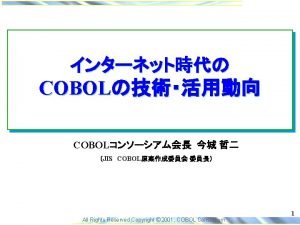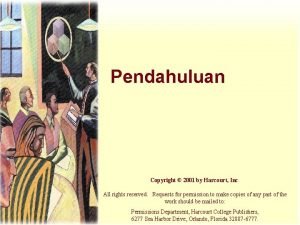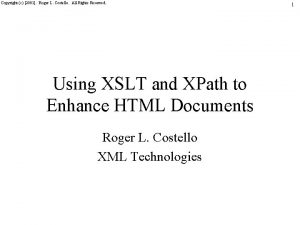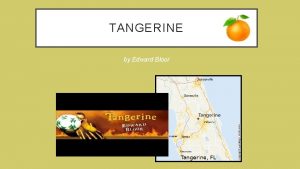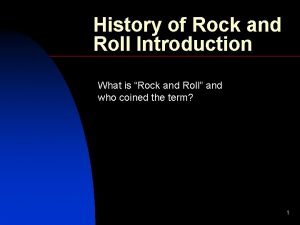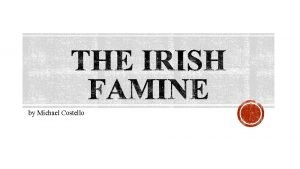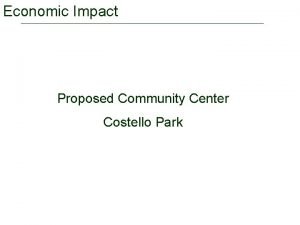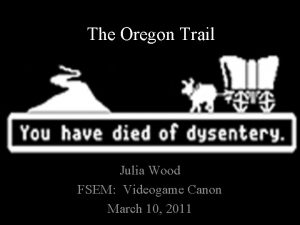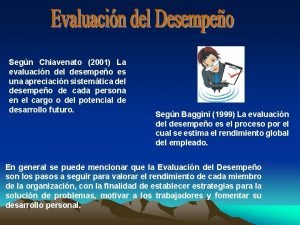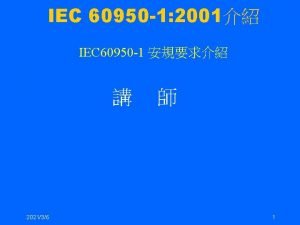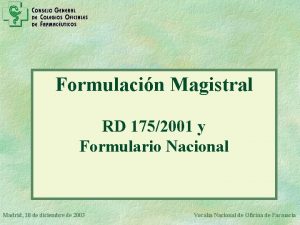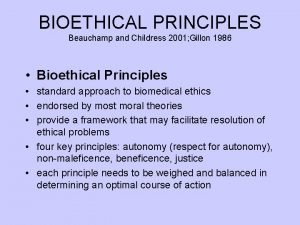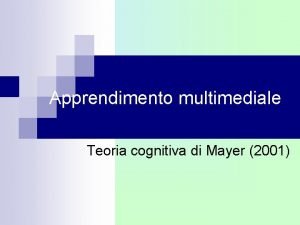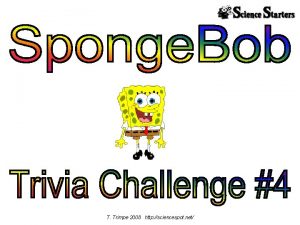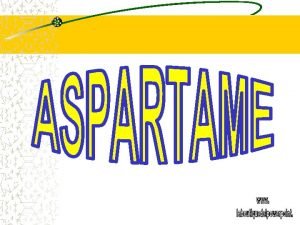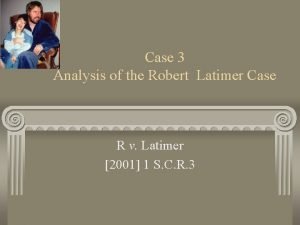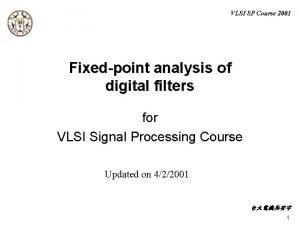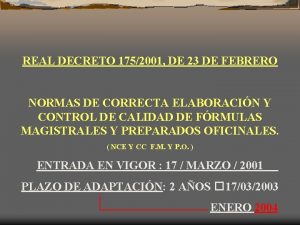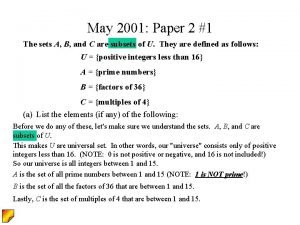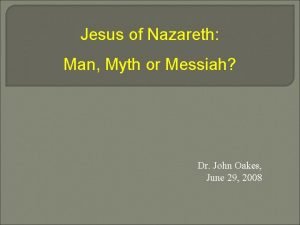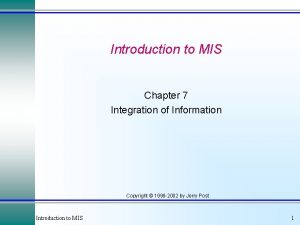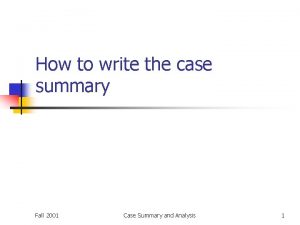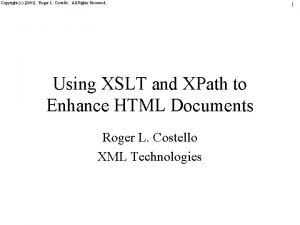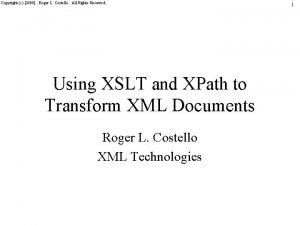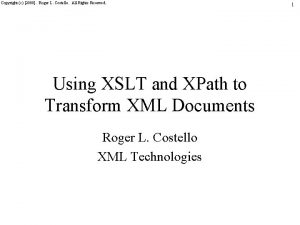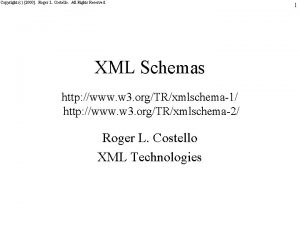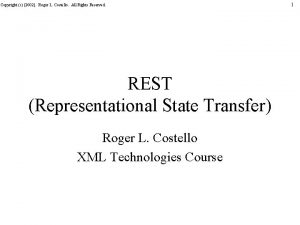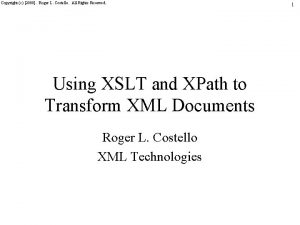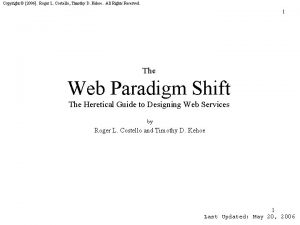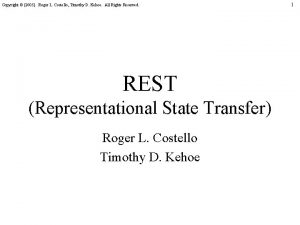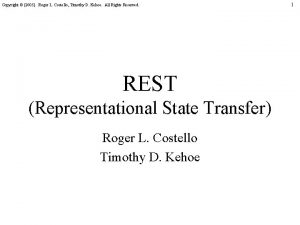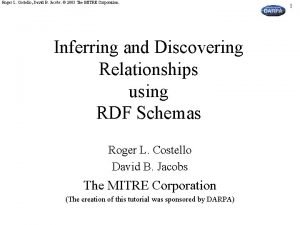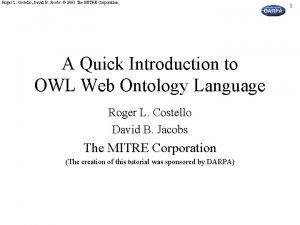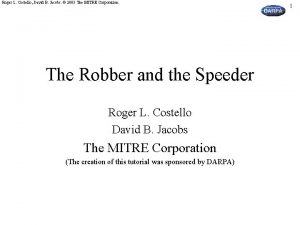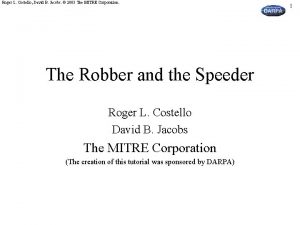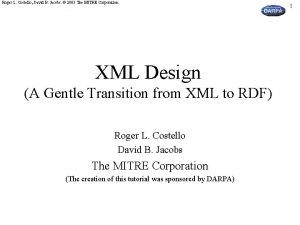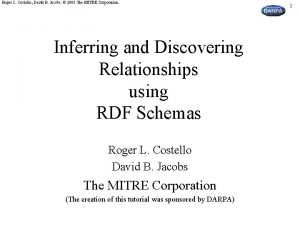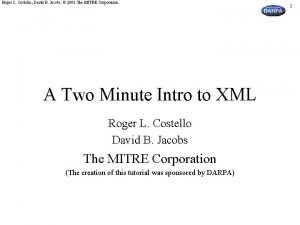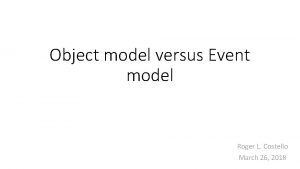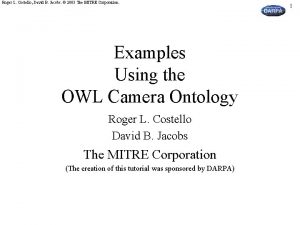Copyright c 2001 Roger L Costello All Rights
![Copyright (c) [2001]. Roger L. Costello. All Rights Reserved. Using XSLT and XPath to Copyright (c) [2001]. Roger L. Costello. All Rights Reserved. Using XSLT and XPath to](https://slidetodoc.com/presentation_image/1009b2960d66a69c68c2a6441ac56512/image-1.jpg)
![Copyright (c) [2001]. Roger L. Costello. All Rights Reserved. Acknowledgement • I wish to Copyright (c) [2001]. Roger L. Costello. All Rights Reserved. Acknowledgement • I wish to](https://slidetodoc.com/presentation_image/1009b2960d66a69c68c2a6441ac56512/image-2.jpg)
![Copyright (c) [2001]. Roger L. Costello. All Rights Reserved. 3 History XSL (low-precision graphics, Copyright (c) [2001]. Roger L. Costello. All Rights Reserved. 3 History XSL (low-precision graphics,](https://slidetodoc.com/presentation_image/1009b2960d66a69c68c2a6441ac56512/image-3.jpg)
![Copyright (c) [2001]. Roger L. Costello. All Rights Reserved. 4 Note • For brevity, Copyright (c) [2001]. Roger L. Costello. All Rights Reserved. 4 Note • For brevity,](https://slidetodoc.com/presentation_image/1009b2960d66a69c68c2a6441ac56512/image-4.jpg)
![Copyright (c) [2001]. Roger L. Costello. All Rights Reserved. 5 Multiple Output Formats • Copyright (c) [2001]. Roger L. Costello. All Rights Reserved. 5 Multiple Output Formats •](https://slidetodoc.com/presentation_image/1009b2960d66a69c68c2a6441ac56512/image-5.jpg)
![Copyright (c) [2001]. Roger L. Costello. All Rights Reserved. xalan/xt/saxon • • • xalan: Copyright (c) [2001]. Roger L. Costello. All Rights Reserved. xalan/xt/saxon • • • xalan:](https://slidetodoc.com/presentation_image/1009b2960d66a69c68c2a6441ac56512/image-6.jpg)
![Copyright (c) [2001]. Roger L. Costello. All Rights Reserved. 7 Styling XML Documents using Copyright (c) [2001]. Roger L. Costello. All Rights Reserved. 7 Styling XML Documents using](https://slidetodoc.com/presentation_image/1009b2960d66a69c68c2a6441ac56512/image-7.jpg)
![Copyright (c) [2001]. Roger L. Costello. All Rights Reserved. HTML Generation • We will Copyright (c) [2001]. Roger L. Costello. All Rights Reserved. HTML Generation • We will](https://slidetodoc.com/presentation_image/1009b2960d66a69c68c2a6441ac56512/image-8.jpg)
![Copyright (c) [2001]. Roger L. Costello. All Rights Reserved. 9 Enhancing HTML Documents with Copyright (c) [2001]. Roger L. Costello. All Rights Reserved. 9 Enhancing HTML Documents with](https://slidetodoc.com/presentation_image/1009b2960d66a69c68c2a6441ac56512/image-9.jpg)
![Copyright (c) [2001]. Roger L. Costello. All Rights Reserved. Enhancing HTML Documents with the Copyright (c) [2001]. Roger L. Costello. All Rights Reserved. Enhancing HTML Documents with the](https://slidetodoc.com/presentation_image/1009b2960d66a69c68c2a6441ac56512/image-10.jpg)
![Copyright (c) [2001]. Roger L. Costello. All Rights Reserved. 11 Embed HTML Document in Copyright (c) [2001]. Roger L. Costello. All Rights Reserved. 11 Embed HTML Document in](https://slidetodoc.com/presentation_image/1009b2960d66a69c68c2a6441ac56512/image-11.jpg)
![Copyright (c) [2001]. Roger L. Costello. All Rights Reserved. 12 Note • The HTML Copyright (c) [2001]. Roger L. Costello. All Rights Reserved. 12 Note • The HTML](https://slidetodoc.com/presentation_image/1009b2960d66a69c68c2a6441ac56512/image-12.jpg)
![Copyright (c) [2001]. Roger L. Costello. All Rights Reserved. Extracting the Member Name <? Copyright (c) [2001]. Roger L. Costello. All Rights Reserved. Extracting the Member Name <?](https://slidetodoc.com/presentation_image/1009b2960d66a69c68c2a6441ac56512/image-13.jpg)
![Copyright (c) [2001]. Roger L. Costello. All Rights Reserved. 14 Note • Notice how Copyright (c) [2001]. Roger L. Costello. All Rights Reserved. 14 Note • Notice how](https://slidetodoc.com/presentation_image/1009b2960d66a69c68c2a6441ac56512/image-14.jpg)
![Copyright (c) [2001]. Roger L. Costello. All Rights Reserved. Extracting a Value from an Copyright (c) [2001]. Roger L. Costello. All Rights Reserved. Extracting a Value from an](https://slidetodoc.com/presentation_image/1009b2960d66a69c68c2a6441ac56512/image-15.jpg)
![Copyright (c) [2001]. Roger L. Costello. All Rights Reserved. 16 Document / PI <? Copyright (c) [2001]. Roger L. Costello. All Rights Reserved. 16 Document / PI <?](https://slidetodoc.com/presentation_image/1009b2960d66a69c68c2a6441ac56512/image-16.jpg)
![Copyright (c) [2001]. Roger L. Costello. All Rights Reserved. Extract the Favorite. Color and Copyright (c) [2001]. Roger L. Costello. All Rights Reserved. Extract the Favorite. Color and](https://slidetodoc.com/presentation_image/1009b2960d66a69c68c2a6441ac56512/image-17.jpg)
![Copyright (c) [2001]. Roger L. Costello. All Rights Reserved. 18 Note Attribute values cannot Copyright (c) [2001]. Roger L. Costello. All Rights Reserved. 18 Note Attribute values cannot](https://slidetodoc.com/presentation_image/1009b2960d66a69c68c2a6441ac56512/image-18.jpg)
![Copyright (c) [2001]. Roger L. Costello. All Rights Reserved. Extract the Home Phone Number Copyright (c) [2001]. Roger L. Costello. All Rights Reserved. Extract the Home Phone Number](https://slidetodoc.com/presentation_image/1009b2960d66a69c68c2a6441ac56512/image-19.jpg)
![Copyright (c) [2001]. Roger L. Costello. All Rights Reserved. 20 Note In this example Copyright (c) [2001]. Roger L. Costello. All Rights Reserved. 20 Note In this example](https://slidetodoc.com/presentation_image/1009b2960d66a69c68c2a6441ac56512/image-20.jpg)
![Copyright (c) [2001]. Roger L. Costello. All Rights Reserved. Review - HTML Table <table Copyright (c) [2001]. Roger L. Costello. All Rights Reserved. Review - HTML Table <table](https://slidetodoc.com/presentation_image/1009b2960d66a69c68c2a6441ac56512/image-21.jpg)
![Copyright (c) [2001]. Roger L. Costello. All Rights Reserved. <table border=“ 1” width=“ 75%”> Copyright (c) [2001]. Roger L. Costello. All Rights Reserved. <table border=“ 1” width=“ 75%”>](https://slidetodoc.com/presentation_image/1009b2960d66a69c68c2a6441ac56512/image-22.jpg)
![Copyright (c) [2001]. Roger L. Costello. All Rights Reserved. Create a Table of Phone Copyright (c) [2001]. Roger L. Costello. All Rights Reserved. Create a Table of Phone](https://slidetodoc.com/presentation_image/1009b2960d66a69c68c2a6441ac56512/image-23.jpg)
![Copyright (c) [2001]. Roger L. Costello. All Rights Reserved. 24 <? xml version="1. 0"? Copyright (c) [2001]. Roger L. Costello. All Rights Reserved. 24 <? xml version="1. 0"?](https://slidetodoc.com/presentation_image/1009b2960d66a69c68c2a6441ac56512/image-24.jpg)
![Copyright (c) [2001]. Roger L. Costello. All Rights Reserved. Iterating through XML Elements <xsl: Copyright (c) [2001]. Roger L. Costello. All Rights Reserved. Iterating through XML Elements <xsl:](https://slidetodoc.com/presentation_image/1009b2960d66a69c68c2a6441ac56512/image-25.jpg)
![Copyright (c) [2001]. Roger L. Costello. All Rights Reserved. 26 Absolute Path versus Relative Copyright (c) [2001]. Roger L. Costello. All Rights Reserved. 26 Absolute Path versus Relative](https://slidetodoc.com/presentation_image/1009b2960d66a69c68c2a6441ac56512/image-26.jpg)
![Copyright (c) [2001]. Roger L. Costello. All Rights Reserved. Special Offer to Platinum Members Copyright (c) [2001]. Roger L. Costello. All Rights Reserved. Special Offer to Platinum Members](https://slidetodoc.com/presentation_image/1009b2960d66a69c68c2a6441ac56512/image-27.jpg)
![Copyright (c) [2001]. Roger L. Costello. All Rights Reserved. <HTML> <HEAD> <TITLE>Welcome</TITLE> </HEAD> <BODY Copyright (c) [2001]. Roger L. Costello. All Rights Reserved. <HTML> <HEAD> <TITLE>Welcome</TITLE> </HEAD> <BODY](https://slidetodoc.com/presentation_image/1009b2960d66a69c68c2a6441ac56512/image-28.jpg)
![Copyright (c) [2001]. Roger L. Costello. All Rights Reserved. 29 Conditional Processing • Use Copyright (c) [2001]. Roger L. Costello. All Rights Reserved. 29 Conditional Processing • Use](https://slidetodoc.com/presentation_image/1009b2960d66a69c68c2a6441ac56512/image-29.jpg)
![Copyright (c) [2001]. Roger L. Costello. All Rights Reserved. Accessing Multiple Parts of the Copyright (c) [2001]. Roger L. Costello. All Rights Reserved. Accessing Multiple Parts of the](https://slidetodoc.com/presentation_image/1009b2960d66a69c68c2a6441ac56512/image-30.jpg)
![Copyright (c) [2001]. Roger L. Costello. All Rights Reserved. <HTML> <HEAD> <TITLE>Welcome</TITLE> </HEAD> <BODY Copyright (c) [2001]. Roger L. Costello. All Rights Reserved. <HTML> <HEAD> <TITLE>Welcome</TITLE> </HEAD> <BODY](https://slidetodoc.com/presentation_image/1009b2960d66a69c68c2a6441ac56512/image-31.jpg)
![Copyright (c) [2001]. Roger L. Costello. All Rights Reserved. 32 Getting the Name when Copyright (c) [2001]. Roger L. Costello. All Rights Reserved. 32 Getting the Name when](https://slidetodoc.com/presentation_image/1009b2960d66a69c68c2a6441ac56512/image-32.jpg)
![Copyright (c) [2001]. Roger L. Costello. All Rights Reserved. 33 Other ways to Access Copyright (c) [2001]. Roger L. Costello. All Rights Reserved. 33 Other ways to Access](https://slidetodoc.com/presentation_image/1009b2960d66a69c68c2a6441ac56512/image-33.jpg)
![Copyright (c) [2001]. Roger L. Costello. All Rights Reserved. Other ways to Access the Copyright (c) [2001]. Roger L. Costello. All Rights Reserved. Other ways to Access the](https://slidetodoc.com/presentation_image/1009b2960d66a69c68c2a6441ac56512/image-34.jpg)
![Copyright (c) [2001]. Roger L. Costello. All Rights Reserved. Other ways to Access the Copyright (c) [2001]. Roger L. Costello. All Rights Reserved. Other ways to Access the](https://slidetodoc.com/presentation_image/1009b2960d66a69c68c2a6441ac56512/image-35.jpg)
![Copyright (c) [2001]. Roger L. Costello. All Rights Reserved. 36 Nodelist This x. Path Copyright (c) [2001]. Roger L. Costello. All Rights Reserved. 36 Nodelist This x. Path](https://slidetodoc.com/presentation_image/1009b2960d66a69c68c2a6441ac56512/image-36.jpg)
![Copyright (c) [2001]. Roger L. Costello. All Rights Reserved. 37 Enhanced XML Document <? Copyright (c) [2001]. Roger L. Costello. All Rights Reserved. 37 Enhanced XML Document <?](https://slidetodoc.com/presentation_image/1009b2960d66a69c68c2a6441ac56512/image-37.jpg)
![Copyright (c) [2001]. Roger L. Costello. All Rights Reserved. Review - HTML Hyperlinking <A Copyright (c) [2001]. Roger L. Costello. All Rights Reserved. Review - HTML Hyperlinking <A](https://slidetodoc.com/presentation_image/1009b2960d66a69c68c2a6441ac56512/image-38.jpg)
![Copyright (c) [2001]. Roger L. Costello. All Rights Reserved. Hyperlink Name to Home Phone Copyright (c) [2001]. Roger L. Costello. All Rights Reserved. Hyperlink Name to Home Phone](https://slidetodoc.com/presentation_image/1009b2960d66a69c68c2a6441ac56512/image-39.jpg)
![Copyright (c) [2001]. Roger L. Costello. All Rights Reserved. <TABLE border="1" width="25%"> <TR><TH>Name</TH></TR> <xsl: Copyright (c) [2001]. Roger L. Costello. All Rights Reserved. <TABLE border="1" width="25%"> <TR><TH>Name</TH></TR> <xsl:](https://slidetodoc.com/presentation_image/1009b2960d66a69c68c2a6441ac56512/image-40.jpg)
![Copyright (c) [2001]. Roger L. Costello. All Rights Reserved. 41 Numbering • There is Copyright (c) [2001]. Roger L. Costello. All Rights Reserved. 41 Numbering • There is](https://slidetodoc.com/presentation_image/1009b2960d66a69c68c2a6441ac56512/image-41.jpg)
![Copyright (c) [2001]. Roger L. Costello. All Rights Reserved. Start Numbering from 0 • Copyright (c) [2001]. Roger L. Costello. All Rights Reserved. Start Numbering from 0 •](https://slidetodoc.com/presentation_image/1009b2960d66a69c68c2a6441ac56512/image-42.jpg)
![Copyright (c) [2001]. Roger L. Costello. All Rights Reserved. format attribute of xsl: number Copyright (c) [2001]. Roger L. Costello. All Rights Reserved. format attribute of xsl: number](https://slidetodoc.com/presentation_image/1009b2960d66a69c68c2a6441ac56512/image-43.jpg)
![Copyright (c) [2001]. Roger L. Costello. All Rights Reserved. 44 format attribute of xsl: Copyright (c) [2001]. Roger L. Costello. All Rights Reserved. 44 format attribute of xsl:](https://slidetodoc.com/presentation_image/1009b2960d66a69c68c2a6441ac56512/image-44.jpg)
![Copyright (c) [2001]. Roger L. Costello. All Rights Reserved. 45 Sorting • There is Copyright (c) [2001]. Roger L. Costello. All Rights Reserved. 45 Sorting • There is](https://slidetodoc.com/presentation_image/1009b2960d66a69c68c2a6441ac56512/image-45.jpg)
![Copyright (c) [2001]. Roger L. Costello. All Rights Reserved. 46 Sorting <xsl: for-each select="/Fitness. Copyright (c) [2001]. Roger L. Costello. All Rights Reserved. 46 Sorting <xsl: for-each select="/Fitness.](https://slidetodoc.com/presentation_image/1009b2960d66a69c68c2a6441ac56512/image-46.jpg)
![Copyright (c) [2001]. Roger L. Costello. All Rights Reserved. concat() function • concat(destination string, Copyright (c) [2001]. Roger L. Costello. All Rights Reserved. concat() function • concat(destination string,](https://slidetodoc.com/presentation_image/1009b2960d66a69c68c2a6441ac56512/image-47.jpg)
![Copyright (c) [2001]. Roger L. Costello. All Rights Reserved. <xsl: for-each select="/Fitness. Center/Member"> <xsl: Copyright (c) [2001]. Roger L. Costello. All Rights Reserved. <xsl: for-each select="/Fitness. Center/Member"> <xsl:](https://slidetodoc.com/presentation_image/1009b2960d66a69c68c2a6441ac56512/image-48.jpg)
![Copyright (c) [2001]. Roger L. Costello. All Rights Reserved. 49 xsl: variable • This Copyright (c) [2001]. Roger L. Costello. All Rights Reserved. 49 xsl: variable • This](https://slidetodoc.com/presentation_image/1009b2960d66a69c68c2a6441ac56512/image-49.jpg)
![Copyright (c) [2001]. Roger L. Costello. All Rights Reserved. Member's Phone Numbers: <TABLE border="1" Copyright (c) [2001]. Roger L. Costello. All Rights Reserved. Member's Phone Numbers: <TABLE border="1"](https://slidetodoc.com/presentation_image/1009b2960d66a69c68c2a6441ac56512/image-50.jpg)
![Copyright (c) [2001]. Roger L. Costello. All Rights Reserved. 51 xsl: variable <xsl: variable Copyright (c) [2001]. Roger L. Costello. All Rights Reserved. 51 xsl: variable <xsl: variable](https://slidetodoc.com/presentation_image/1009b2960d66a69c68c2a6441ac56512/image-51.jpg)
![Copyright (c) [2001]. Roger L. Costello. All Rights Reserved. 52 xsl: variable • A Copyright (c) [2001]. Roger L. Costello. All Rights Reserved. 52 xsl: variable • A](https://slidetodoc.com/presentation_image/1009b2960d66a69c68c2a6441ac56512/image-52.jpg)
![Copyright (c) [2001]. Roger L. Costello. All Rights Reserved. 53 Member's Phone Numbers: <TABLE Copyright (c) [2001]. Roger L. Costello. All Rights Reserved. 53 Member's Phone Numbers: <TABLE](https://slidetodoc.com/presentation_image/1009b2960d66a69c68c2a6441ac56512/image-53.jpg)
![Copyright (c) [2001]. Roger L. Costello. All Rights Reserved. Global Variables • You can Copyright (c) [2001]. Roger L. Costello. All Rights Reserved. Global Variables • You can](https://slidetodoc.com/presentation_image/1009b2960d66a69c68c2a6441ac56512/image-54.jpg)
![Copyright (c) [2001]. Roger L. Costello. All Rights Reserved. 55 Problem • Suppose that Copyright (c) [2001]. Roger L. Costello. All Rights Reserved. 55 Problem • Suppose that](https://slidetodoc.com/presentation_image/1009b2960d66a69c68c2a6441ac56512/image-55.jpg)
![Copyright (c) [2001]. Roger L. Costello. All Rights Reserved. 56 Let’s add some statements Copyright (c) [2001]. Roger L. Costello. All Rights Reserved. 56 Let’s add some statements](https://slidetodoc.com/presentation_image/1009b2960d66a69c68c2a6441ac56512/image-56.jpg)
![Copyright (c) [2001]. Roger L. Costello. All Rights Reserved. 57 Here’s what we would Copyright (c) [2001]. Roger L. Costello. All Rights Reserved. 57 Here’s what we would](https://slidetodoc.com/presentation_image/1009b2960d66a69c68c2a6441ac56512/image-57.jpg)
![Copyright (c) [2001]. Roger L. Costello. All Rights Reserved. Problem - Solution In all Copyright (c) [2001]. Roger L. Costello. All Rights Reserved. Problem - Solution In all](https://slidetodoc.com/presentation_image/1009b2960d66a69c68c2a6441ac56512/image-58.jpg)
![Copyright (c) [2001]. Roger L. Costello. All Rights Reserved. 59 Problem - Solution Member's Copyright (c) [2001]. Roger L. Costello. All Rights Reserved. 59 Problem - Solution Member's](https://slidetodoc.com/presentation_image/1009b2960d66a69c68c2a6441ac56512/image-59.jpg)
![Copyright (c) [2001]. Roger L. Costello. All Rights Reserved. 60 contains() function • contains(string Copyright (c) [2001]. Roger L. Costello. All Rights Reserved. 60 contains() function • contains(string](https://slidetodoc.com/presentation_image/1009b2960d66a69c68c2a6441ac56512/image-60.jpg)
![Copyright (c) [2001]. Roger L. Costello. All Rights Reserved. 61 xsl: choose • xsl: Copyright (c) [2001]. Roger L. Costello. All Rights Reserved. 61 xsl: choose • xsl:](https://slidetodoc.com/presentation_image/1009b2960d66a69c68c2a6441ac56512/image-61.jpg)
![Copyright (c) [2001]. Roger L. Costello. All Rights Reserved. Implementing an if-then-else • There Copyright (c) [2001]. Roger L. Costello. All Rights Reserved. Implementing an if-then-else • There](https://slidetodoc.com/presentation_image/1009b2960d66a69c68c2a6441ac56512/image-62.jpg)
![Copyright (c) [2001]. Roger L. Costello. All Rights Reserved. 63 substring-before() String Function Here’s Copyright (c) [2001]. Roger L. Costello. All Rights Reserved. 63 substring-before() String Function Here’s](https://slidetodoc.com/presentation_image/1009b2960d66a69c68c2a6441ac56512/image-63.jpg)
![Copyright (c) [2001]. Roger L. Costello. All Rights Reserved. 64 substring-after() String Function Here’s Copyright (c) [2001]. Roger L. Costello. All Rights Reserved. 64 substring-after() String Function Here’s](https://slidetodoc.com/presentation_image/1009b2960d66a69c68c2a6441ac56512/image-64.jpg)
![Copyright (c) [2001]. Roger L. Costello. All Rights Reserved. starts-with() String Function Here’s the Copyright (c) [2001]. Roger L. Costello. All Rights Reserved. starts-with() String Function Here’s the](https://slidetodoc.com/presentation_image/1009b2960d66a69c68c2a6441ac56512/image-65.jpg)
![Copyright (c) [2001]. Roger L. Costello. All Rights Reserved. substring() function • substring(string, i, Copyright (c) [2001]. Roger L. Costello. All Rights Reserved. substring() function • substring(string, i,](https://slidetodoc.com/presentation_image/1009b2960d66a69c68c2a6441ac56512/image-66.jpg)
![Copyright (c) [2001]. Roger L. Costello. All Rights Reserved. string-length() function • string-length(string) returns Copyright (c) [2001]. Roger L. Costello. All Rights Reserved. string-length() function • string-length(string) returns](https://slidetodoc.com/presentation_image/1009b2960d66a69c68c2a6441ac56512/image-67.jpg)
![Copyright (c) [2001]. Roger L. Costello. All Rights Reserved. 68 translate() function translate(string, from-pattern, Copyright (c) [2001]. Roger L. Costello. All Rights Reserved. 68 translate() function translate(string, from-pattern,](https://slidetodoc.com/presentation_image/1009b2960d66a69c68c2a6441ac56512/image-68.jpg)
![Copyright (c) [2001]. Roger L. Costello. All Rights Reserved. Boolean and Relational Operators • Copyright (c) [2001]. Roger L. Costello. All Rights Reserved. Boolean and Relational Operators •](https://slidetodoc.com/presentation_image/1009b2960d66a69c68c2a6441ac56512/image-69.jpg)
![Copyright (c) [2001]. Roger L. Costello. All Rights Reserved. 70 Arithmetic • The arithmetic Copyright (c) [2001]. Roger L. Costello. All Rights Reserved. 70 Arithmetic • The arithmetic](https://slidetodoc.com/presentation_image/1009b2960d66a69c68c2a6441ac56512/image-70.jpg)
![Copyright (c) [2001]. Roger L. Costello. All Rights Reserved. Arithmetic functions • sum(node set) Copyright (c) [2001]. Roger L. Costello. All Rights Reserved. Arithmetic functions • sum(node set)](https://slidetodoc.com/presentation_image/1009b2960d66a69c68c2a6441ac56512/image-71.jpg)
![Copyright (c) [2001]. Roger L. Costello. All Rights Reserved. 72 Enhanced XML Document <? Copyright (c) [2001]. Roger L. Costello. All Rights Reserved. 72 Enhanced XML Document <?](https://slidetodoc.com/presentation_image/1009b2960d66a69c68c2a6441ac56512/image-72.jpg)
![Copyright (c) [2001]. Roger L. Costello. All Rights Reserved. Compute Membership Revenue Membership Fee Copyright (c) [2001]. Roger L. Costello. All Rights Reserved. Compute Membership Revenue Membership Fee](https://slidetodoc.com/presentation_image/1009b2960d66a69c68c2a6441ac56512/image-73.jpg)
![Copyright (c) [2001]. Roger L. Costello. All Rights Reserved. xsl: attribute • This XSL Copyright (c) [2001]. Roger L. Costello. All Rights Reserved. xsl: attribute • This XSL](https://slidetodoc.com/presentation_image/1009b2960d66a69c68c2a6441ac56512/image-74.jpg)
![Copyright (c) [2001]. Roger L. Costello. All Rights Reserved. Coloring alternate rows Member Names: Copyright (c) [2001]. Roger L. Costello. All Rights Reserved. Coloring alternate rows Member Names:](https://slidetodoc.com/presentation_image/1009b2960d66a69c68c2a6441ac56512/image-75.jpg)
![Copyright (c) [2001]. Roger L. Costello. All Rights Reserved. 76 count() function count(set of Copyright (c) [2001]. Roger L. Costello. All Rights Reserved. 76 count() function count(set of](https://slidetodoc.com/presentation_image/1009b2960d66a69c68c2a6441ac56512/image-76.jpg)
![Copyright (c) [2001]. Roger L. Costello. All Rights Reserved. 77 Selecting all Elements/Attributes <xsl: Copyright (c) [2001]. Roger L. Costello. All Rights Reserved. 77 Selecting all Elements/Attributes <xsl:](https://slidetodoc.com/presentation_image/1009b2960d66a69c68c2a6441ac56512/image-77.jpg)
![Copyright (c) [2001]. Roger L. Costello. All Rights Reserved. Getting the Name of the Copyright (c) [2001]. Roger L. Costello. All Rights Reserved. Getting the Name of the](https://slidetodoc.com/presentation_image/1009b2960d66a69c68c2a6441ac56512/image-78.jpg)
![Copyright (c) [2001]. Roger L. Costello. All Rights Reserved. When to use Curly Braces? Copyright (c) [2001]. Roger L. Costello. All Rights Reserved. When to use Curly Braces?](https://slidetodoc.com/presentation_image/1009b2960d66a69c68c2a6441ac56512/image-79.jpg)
![Copyright (c) [2001]. Roger L. Costello. All Rights Reserved. document( ) Function • This Copyright (c) [2001]. Roger L. Costello. All Rights Reserved. document( ) Function • This](https://slidetodoc.com/presentation_image/1009b2960d66a69c68c2a6441ac56512/image-80.jpg)
![Copyright (c) [2001]. Roger L. Costello. All Rights Reserved. Fitness Centers Merger • Another Copyright (c) [2001]. Roger L. Costello. All Rights Reserved. Fitness Centers Merger • Another](https://slidetodoc.com/presentation_image/1009b2960d66a69c68c2a6441ac56512/image-81.jpg)
![Copyright (c) [2001]. Roger L. Costello. All Rights Reserved. 82 <TABLE border="1" width="75%"> <TR><TH>Name</TH><TH>Phone(home)</TH>. Copyright (c) [2001]. Roger L. Costello. All Rights Reserved. 82 <TABLE border="1" width="75%"> <TR><TH>Name</TH><TH>Phone(home)</TH>.](https://slidetodoc.com/presentation_image/1009b2960d66a69c68c2a6441ac56512/image-82.jpg)
![Copyright (c) [2001]. Roger L. Costello. All Rights Reserved. Parameterized Processing • You can Copyright (c) [2001]. Roger L. Costello. All Rights Reserved. Parameterized Processing • You can](https://slidetodoc.com/presentation_image/1009b2960d66a69c68c2a6441ac56512/image-83.jpg)
![Copyright (c) [2001]. Roger L. Costello. All Rights Reserved. <xsl: template match="/"> <HTML> <HEAD> Copyright (c) [2001]. Roger L. Costello. All Rights Reserved. <xsl: template match="/"> <HTML> <HEAD>](https://slidetodoc.com/presentation_image/1009b2960d66a69c68c2a6441ac56512/image-84.jpg)
![Copyright (c) [2001]. Roger L. Costello. All Rights Reserved. Call by Reference • How Copyright (c) [2001]. Roger L. Costello. All Rights Reserved. Call by Reference • How](https://slidetodoc.com/presentation_image/1009b2960d66a69c68c2a6441ac56512/image-85.jpg)
![Copyright (c) [2001]. Roger L. Costello. All Rights Reserved. 86 <xsl: template match="/"> <HTML> Copyright (c) [2001]. Roger L. Costello. All Rights Reserved. 86 <xsl: template match="/"> <HTML>](https://slidetodoc.com/presentation_image/1009b2960d66a69c68c2a6441ac56512/image-86.jpg)
![Copyright (c) [2001]. Roger L. Costello. All Rights Reserved. 87 Problem: Determine if all Copyright (c) [2001]. Roger L. Costello. All Rights Reserved. 87 Problem: Determine if all](https://slidetodoc.com/presentation_image/1009b2960d66a69c68c2a6441ac56512/image-87.jpg)
![Copyright (c) [2001]. Roger L. Costello. All Rights Reserved. <xsl: template match="/"> <xsl: text>All Copyright (c) [2001]. Roger L. Costello. All Rights Reserved. <xsl: template match="/"> <xsl: text>All](https://slidetodoc.com/presentation_image/1009b2960d66a69c68c2a6441ac56512/image-88.jpg)
![Copyright (c) [2001]. Roger L. Costello. All Rights Reserved. generate-id() • Use this function Copyright (c) [2001]. Roger L. Costello. All Rights Reserved. generate-id() • Use this function](https://slidetodoc.com/presentation_image/1009b2960d66a69c68c2a6441ac56512/image-89.jpg)
![Copyright (c) [2001]. Roger L. Costello. All Rights Reserved. Using generate-id() to Uniquely Identify Copyright (c) [2001]. Roger L. Costello. All Rights Reserved. Using generate-id() to Uniquely Identify](https://slidetodoc.com/presentation_image/1009b2960d66a69c68c2a6441ac56512/image-90.jpg)
![Copyright (c) [2001]. Roger L. Costello. All Rights Reserved. <TABLE border="1" width="25%"> <TR><TH>Name</TH></TR> <xsl: Copyright (c) [2001]. Roger L. Costello. All Rights Reserved. <TABLE border="1" width="25%"> <TR><TH>Name</TH></TR> <xsl:](https://slidetodoc.com/presentation_image/1009b2960d66a69c68c2a6441ac56512/image-91.jpg)
![Copyright (c) [2001]. Roger L. Costello. All Rights Reserved. Same (XML) Data, Multiple Views Copyright (c) [2001]. Roger L. Costello. All Rights Reserved. Same (XML) Data, Multiple Views](https://slidetodoc.com/presentation_image/1009b2960d66a69c68c2a6441ac56512/image-92.jpg)
![Copyright (c) [2001]. Roger L. Costello. All Rights Reserved. 93 Multiple Stylesheets to provide Copyright (c) [2001]. Roger L. Costello. All Rights Reserved. 93 Multiple Stylesheets to provide](https://slidetodoc.com/presentation_image/1009b2960d66a69c68c2a6441ac56512/image-93.jpg)
![Copyright (c) [2001]. Roger L. Costello. All Rights Reserved. 94 Fitness. Center. html - Copyright (c) [2001]. Roger L. Costello. All Rights Reserved. 94 Fitness. Center. html -](https://slidetodoc.com/presentation_image/1009b2960d66a69c68c2a6441ac56512/image-94.jpg)
![Copyright (c) [2001]. Roger L. Costello. All Rights Reserved. 95 Fitness. Center. html <HTML> Copyright (c) [2001]. Roger L. Costello. All Rights Reserved. 95 Fitness. Center. html <HTML>](https://slidetodoc.com/presentation_image/1009b2960d66a69c68c2a6441ac56512/image-95.jpg)
![Copyright (c) [2001]. Roger L. Costello. All Rights Reserved. 96 Body. html <HTML> <HEAD> Copyright (c) [2001]. Roger L. Costello. All Rights Reserved. 96 Body. html <HTML> <HEAD>](https://slidetodoc.com/presentation_image/1009b2960d66a69c68c2a6441ac56512/image-96.jpg)
![Copyright (c) [2001]. Roger L. Costello. All Rights Reserved. 97 Controls. html (tracing through Copyright (c) [2001]. Roger L. Costello. All Rights Reserved. 97 Controls. html (tracing through](https://slidetodoc.com/presentation_image/1009b2960d66a69c68c2a6441ac56512/image-97.jpg)
![Copyright (c) [2001]. Roger L. Costello. All Rights Reserved. Controls. html (code to Show. Copyright (c) [2001]. Roger L. Costello. All Rights Reserved. Controls. html (code to Show.](https://slidetodoc.com/presentation_image/1009b2960d66a69c68c2a6441ac56512/image-98.jpg)
![Copyright (c) [2001]. Roger L. Costello. All Rights Reserved. Using SAXON in a Browser Copyright (c) [2001]. Roger L. Costello. All Rights Reserved. Using SAXON in a Browser](https://slidetodoc.com/presentation_image/1009b2960d66a69c68c2a6441ac56512/image-99.jpg)
![Copyright (c) [2001]. Roger L. Costello. All Rights Reserved. 100 Inserting spaces into HTML Copyright (c) [2001]. Roger L. Costello. All Rights Reserved. 100 Inserting spaces into HTML](https://slidetodoc.com/presentation_image/1009b2960d66a69c68c2a6441ac56512/image-100.jpg)
![Copyright (c) [2001]. Roger L. Costello. All Rights Reserved. Debugging your Stylesheets using xsl: Copyright (c) [2001]. Roger L. Costello. All Rights Reserved. Debugging your Stylesheets using xsl:](https://slidetodoc.com/presentation_image/1009b2960d66a69c68c2a6441ac56512/image-101.jpg)
![Copyright (c) [2001]. Roger L. Costello. All Rights Reserved. 102 Example using xsl: message Copyright (c) [2001]. Roger L. Costello. All Rights Reserved. 102 Example using xsl: message](https://slidetodoc.com/presentation_image/1009b2960d66a69c68c2a6441ac56512/image-102.jpg)
![Copyright (c) [2001]. Roger L. Costello. All Rights Reserved. system-property() function • The system-property(property Copyright (c) [2001]. Roger L. Costello. All Rights Reserved. system-property() function • The system-property(property](https://slidetodoc.com/presentation_image/1009b2960d66a69c68c2a6441ac56512/image-103.jpg)
![Copyright (c) [2001]. Roger L. Costello. All Rights Reserved. 104 Recommended Practice <? xml Copyright (c) [2001]. Roger L. Costello. All Rights Reserved. 104 Recommended Practice <? xml](https://slidetodoc.com/presentation_image/1009b2960d66a69c68c2a6441ac56512/image-104.jpg)
![Copyright (c) [2001]. Roger L. Costello. All Rights Reserved. 105 Embedded Stylesheets • You Copyright (c) [2001]. Roger L. Costello. All Rights Reserved. 105 Embedded Stylesheets • You](https://slidetodoc.com/presentation_image/1009b2960d66a69c68c2a6441ac56512/image-105.jpg)
![Copyright (c) [2001]. Roger L. Costello. All Rights Reserved. 106 Embedded Stylesheets You must Copyright (c) [2001]. Roger L. Costello. All Rights Reserved. 106 Embedded Stylesheets You must](https://slidetodoc.com/presentation_image/1009b2960d66a69c68c2a6441ac56512/image-106.jpg)
- Slides: 106
![Copyright c 2001 Roger L Costello All Rights Reserved Using XSLT and XPath to Copyright (c) [2001]. Roger L. Costello. All Rights Reserved. Using XSLT and XPath to](https://slidetodoc.com/presentation_image/1009b2960d66a69c68c2a6441ac56512/image-1.jpg)
Copyright (c) [2001]. Roger L. Costello. All Rights Reserved. Using XSLT and XPath to Enhance HTML Documents Roger L. Costello XML Technologies 1
![Copyright c 2001 Roger L Costello All Rights Reserved Acknowledgement I wish to Copyright (c) [2001]. Roger L. Costello. All Rights Reserved. Acknowledgement • I wish to](https://slidetodoc.com/presentation_image/1009b2960d66a69c68c2a6441ac56512/image-2.jpg)
Copyright (c) [2001]. Roger L. Costello. All Rights Reserved. Acknowledgement • I wish to thank David Jacobs for showing me a new way of looking at HTML and XSLT/XPath • Many of the examples that I use in this tutorial come straight from David's excellent paper, Rescuing XSLT from Niche Status (see http: //www. xfront. com) 2
![Copyright c 2001 Roger L Costello All Rights Reserved 3 History XSL lowprecision graphics Copyright (c) [2001]. Roger L. Costello. All Rights Reserved. 3 History XSL (low-precision graphics,](https://slidetodoc.com/presentation_image/1009b2960d66a69c68c2a6441ac56512/image-3.jpg)
Copyright (c) [2001]. Roger L. Costello. All Rights Reserved. 3 History XSL (low-precision graphics, e. g. , HTML, text, XML) (high-precision graphics, e. g. , PDF) XQuery XLink/ XPointer XSLT XML Schemas XPath XSLT XSL
![Copyright c 2001 Roger L Costello All Rights Reserved 4 Note For brevity Copyright (c) [2001]. Roger L. Costello. All Rights Reserved. 4 Note • For brevity,](https://slidetodoc.com/presentation_image/1009b2960d66a69c68c2a6441ac56512/image-4.jpg)
Copyright (c) [2001]. Roger L. Costello. All Rights Reserved. 4 Note • For brevity, instead of using the term XSLT/XPath, I will simply call it XSL.
![Copyright c 2001 Roger L Costello All Rights Reserved 5 Multiple Output Formats Copyright (c) [2001]. Roger L. Costello. All Rights Reserved. 5 Multiple Output Formats •](https://slidetodoc.com/presentation_image/1009b2960d66a69c68c2a6441ac56512/image-5.jpg)
Copyright (c) [2001]. Roger L. Costello. All Rights Reserved. 5 Multiple Output Formats • XSL may be used to generate either HTML, XML, or text XSL XML XSL Processor HTML (or XML or text)
![Copyright c 2001 Roger L Costello All Rights Reserved xalanxtsaxon xalan Copyright (c) [2001]. Roger L. Costello. All Rights Reserved. xalan/xt/saxon • • • xalan:](https://slidetodoc.com/presentation_image/1009b2960d66a69c68c2a6441ac56512/image-6.jpg)
Copyright (c) [2001]. Roger L. Costello. All Rights Reserved. xalan/xt/saxon • • • xalan: A free XSL processor, implemented in Java, from Apache (http: //www. apache. org/) xt: A free XSL processor, implemented in Java, from James Clark (http: //www. jclark. com/) saxon: A free XSL processor, implemented in Java, from Michael Kay (http: //users. iclway. co. uk/mhkay/saxon XML XSL xalan/xt/saxon HTML (or XML or text) Invoking from a DOS command line: run-xalan Fitness. Center. xml Fitness. Center. xsl Fitness. Center. html run-xt Fitness. Center. xml Fitness. Center. xsl Fitness. Center. html run-saxon Fitness. Center. xml Fitness. Center. xsl Fitness. Center. html 6
![Copyright c 2001 Roger L Costello All Rights Reserved 7 Styling XML Documents using Copyright (c) [2001]. Roger L. Costello. All Rights Reserved. 7 Styling XML Documents using](https://slidetodoc.com/presentation_image/1009b2960d66a69c68c2a6441ac56512/image-7.jpg)
Copyright (c) [2001]. Roger L. Costello. All Rights Reserved. 7 Styling XML Documents using IE 6 or Netscape 7 • • Put a stylesheet PI at the top of your XML document. Now you can simply drop the XML document into the browser and the XML will be automatically styled using the stylesheet referenced in the stylesheet PI. <? xml version="1. 0"? > <? xml-stylesheet type="text/xsl" href="Fitness. Center. xsl"? > <Fitness. Center> <Member level="platinum"> <Name>Jeff</Name> <Phone type="home">555 -1234</Phone> <Phone type="work">555 -4321</Phone> <Favorite. Color>lightgrey</Favorite. Color> </Member> </Fitness. Center> Add this stylesheet PI to the top of your XML document
![Copyright c 2001 Roger L Costello All Rights Reserved HTML Generation We will Copyright (c) [2001]. Roger L. Costello. All Rights Reserved. HTML Generation • We will](https://slidetodoc.com/presentation_image/1009b2960d66a69c68c2a6441ac56512/image-8.jpg)
Copyright (c) [2001]. Roger L. Costello. All Rights Reserved. HTML Generation • We will first use XSL to generate HTML documents • When generating HTML, XSL should be viewed as a tool to enhance HTML documents. – That is, the HTML documents may be enhanced by extracting data out of XML documents – XSL provides elements (tags) for extracting the XML data, thus allowing us to enhance HTML documents with data from an XML document 8
![Copyright c 2001 Roger L Costello All Rights Reserved 9 Enhancing HTML Documents with Copyright (c) [2001]. Roger L. Costello. All Rights Reserved. 9 Enhancing HTML Documents with](https://slidetodoc.com/presentation_image/1009b2960d66a69c68c2a6441ac56512/image-9.jpg)
Copyright (c) [2001]. Roger L. Costello. All Rights Reserved. 9 Enhancing HTML Documents with XML Data XML Document XML data XSL Processor XSL element XML data HTML Document (with embedded XSL elements)
![Copyright c 2001 Roger L Costello All Rights Reserved Enhancing HTML Documents with the Copyright (c) [2001]. Roger L. Costello. All Rights Reserved. Enhancing HTML Documents with the](https://slidetodoc.com/presentation_image/1009b2960d66a69c68c2a6441ac56512/image-10.jpg)
Copyright (c) [2001]. Roger L. Costello. All Rights Reserved. Enhancing HTML Documents with the Following XML Data <? xml version="1. 0"? > <? xml-stylesheet type="text/xsl" href="Fitness. Center. xsl"? > <Fitness. Center> <Member level="platinum"> <Name>Jeff</Name> <Phone type="home">555 -1234</Phone> <Phone type="work">555 -4321</Phone> <Favorite. Color>lightgrey</Favorite. Color> </Member> </Fitness. Center> Fitness. Center. xml 10
![Copyright c 2001 Roger L Costello All Rights Reserved 11 Embed HTML Document in Copyright (c) [2001]. Roger L. Costello. All Rights Reserved. 11 Embed HTML Document in](https://slidetodoc.com/presentation_image/1009b2960d66a69c68c2a6441ac56512/image-11.jpg)
Copyright (c) [2001]. Roger L. Costello. All Rights Reserved. 11 Embed HTML Document in an XSL Template <? xml version="1. 0"? > <xsl: stylesheet xmlns: xsl="http: //www. w 3. org/1999/XSL/Transform" version="1. 0"> <xsl: output method="html"/> <xsl: template match="/"> <HTML> <HEAD> <TITLE>Welcome</TITLE> </HEAD> <BODY> Welcome! </BODY> </HTML> </xsl: template> </xsl: stylesheet> Fitness. Center. xsl (see html-example 01) Note how we have the HTML document embedded within an XSL template
![Copyright c 2001 Roger L Costello All Rights Reserved 12 Note The HTML Copyright (c) [2001]. Roger L. Costello. All Rights Reserved. 12 Note • The HTML](https://slidetodoc.com/presentation_image/1009b2960d66a69c68c2a6441ac56512/image-12.jpg)
Copyright (c) [2001]. Roger L. Costello. All Rights Reserved. 12 Note • The HTML is embedded within an XSL template, which is an XML document – Consequently, the HTML must be well formed, i. e. , every start tag must have an end tag • Because the HTML is embedded within an XSL template, we are able to add XSL elements to the HTML, allowing us to extract data out of XML documents • Let's customize the HTML welcome page by putting in the member's name. This is achieved by extracting the name from the XML document. We use an XSL element to do this.
![Copyright c 2001 Roger L Costello All Rights Reserved Extracting the Member Name Copyright (c) [2001]. Roger L. Costello. All Rights Reserved. Extracting the Member Name <?](https://slidetodoc.com/presentation_image/1009b2960d66a69c68c2a6441ac56512/image-13.jpg)
Copyright (c) [2001]. Roger L. Costello. All Rights Reserved. Extracting the Member Name <? xml version="1. 0"? > <xsl: stylesheet xmlns: xsl="http: //www. w 3. org/1999/XSL/Transform" version="1. 0"> <xsl: output method="html"/> <xsl: template match="/"> <HTML> <HEAD> <TITLE>Welcome</TITLE> </HEAD> <BODY> Welcome <xsl: value-of select="/Fitness. Center/Member/Name"/>! </BODY> </HTML> </xsl: template> </xsl: stylesheet> (see html-example 02) 13
![Copyright c 2001 Roger L Costello All Rights Reserved 14 Note Notice how Copyright (c) [2001]. Roger L. Costello. All Rights Reserved. 14 Note • Notice how](https://slidetodoc.com/presentation_image/1009b2960d66a69c68c2a6441ac56512/image-14.jpg)
Copyright (c) [2001]. Roger L. Costello. All Rights Reserved. 14 Note • Notice how we have enhanced the HTML document by using data from the XML document!
![Copyright c 2001 Roger L Costello All Rights Reserved Extracting a Value from an Copyright (c) [2001]. Roger L. Costello. All Rights Reserved. Extracting a Value from an](https://slidetodoc.com/presentation_image/1009b2960d66a69c68c2a6441ac56512/image-15.jpg)
Copyright (c) [2001]. Roger L. Costello. All Rights Reserved. Extracting a Value from an XML Document, Navigating the XML Document 15 • Extracting values: – use the <xsl: value-of select="…"/> XSL element • Navigating: – The slash ("/") indicates parent/child relationship – A slash at the beginning of the path indicates that it is an absolute path, starting from the top of the XML document /Fitness. Center/Member/Name "Start from the top of the XML document, go to the Fitness. Center element, from there go to the Member element, and from there go to the Name element. "
![Copyright c 2001 Roger L Costello All Rights Reserved 16 Document PI Copyright (c) [2001]. Roger L. Costello. All Rights Reserved. 16 Document / PI <?](https://slidetodoc.com/presentation_image/1009b2960d66a69c68c2a6441ac56512/image-16.jpg)
Copyright (c) [2001]. Roger L. Costello. All Rights Reserved. 16 Document / PI <? xml version=“ 1. 0”? > Element Fitness. Center Element Member Element Name Text Jeff Element Phone Element Favorite. Color Text 555 -1234 Text 555 -4321 Text lightgrey
![Copyright c 2001 Roger L Costello All Rights Reserved Extract the Favorite Color and Copyright (c) [2001]. Roger L. Costello. All Rights Reserved. Extract the Favorite. Color and](https://slidetodoc.com/presentation_image/1009b2960d66a69c68c2a6441ac56512/image-17.jpg)
Copyright (c) [2001]. Roger L. Costello. All Rights Reserved. Extract the Favorite. Color and use it as the bgcolor <? xml version="1. 0"? > <xsl: stylesheet xmlns: xsl="http: //www. w 3. org/1999/XSL/Transform" version="1. 0"> <xsl: output method="html"/> <xsl: template match="/"> <HTML> <HEAD> <TITLE>Welcome</TITLE> </HEAD> <BODY bgcolor="{/Fitness. Center/Member/Favorite. Color}"> Welcome <xsl: value-of select="/Fitness. Center/Member/Name"/>! </BODY> </HTML> </xsl: template> </xsl: stylesheet> (see html-example 03) 17
![Copyright c 2001 Roger L Costello All Rights Reserved 18 Note Attribute values cannot Copyright (c) [2001]. Roger L. Costello. All Rights Reserved. 18 Note Attribute values cannot](https://slidetodoc.com/presentation_image/1009b2960d66a69c68c2a6441ac56512/image-18.jpg)
Copyright (c) [2001]. Roger L. Costello. All Rights Reserved. 18 Note Attribute values cannot contain "<" nor ">" - Consequently, the following is NOT valid: <Body bgcolor="<xsl: value-of select='/Fitness. Center/Member/Favorite. Color'/>"> To extract the value of an XML element and use it as an attribute value you must use curly braces: <Body bgcolor="{/Fitness. Center/Member/Favorite. Color}"> Evaluate the expression within the curly braces. Assign the value to the attribute.
![Copyright c 2001 Roger L Costello All Rights Reserved Extract the Home Phone Number Copyright (c) [2001]. Roger L. Costello. All Rights Reserved. Extract the Home Phone Number](https://slidetodoc.com/presentation_image/1009b2960d66a69c68c2a6441ac56512/image-19.jpg)
Copyright (c) [2001]. Roger L. Costello. All Rights Reserved. Extract the Home Phone Number <? xml version="1. 0"? > <xsl: stylesheet xmlns: xsl="http: //www. w 3. org/1999/XSL/Transform" version="1. 0"> <xsl: output method="html"/> <xsl: template match="/"> <HTML> <HEAD> <TITLE>Welcome</TITLE> </HEAD> <BODY bgcolor="{/Fitness. Center/Member/Favorite. Color}"> Welcome <xsl: value-of select="/Fitness. Center/Member/Name"/>! <BR/> Your home phone number is: <xsl: value-of select="/Fitness. Center/Member/Phone[@type='home']"/> </BODY> </HTML> </xsl: template> </xsl: stylesheet> (see html-example 04) 19
![Copyright c 2001 Roger L Costello All Rights Reserved 20 Note In this example Copyright (c) [2001]. Roger L. Costello. All Rights Reserved. 20 Note In this example](https://slidetodoc.com/presentation_image/1009b2960d66a69c68c2a6441ac56512/image-20.jpg)
Copyright (c) [2001]. Roger L. Costello. All Rights Reserved. 20 Note In this example we want "the Phone element where the value of its type attribute equals 'home' ": <xsl: value-of select="/Fitness. Center/Member/Phone[@type='home']"/> The expression within […] is called a "predicate". Its purpose is to filter. Note the use of the single quotes within the double quotes. select=" … ' …' …"
![Copyright c 2001 Roger L Costello All Rights Reserved Review HTML Table table Copyright (c) [2001]. Roger L. Costello. All Rights Reserved. Review - HTML Table <table](https://slidetodoc.com/presentation_image/1009b2960d66a69c68c2a6441ac56512/image-21.jpg)
Copyright (c) [2001]. Roger L. Costello. All Rights Reserved. Review - HTML Table <table border=“ 1” width=“ 100%”> <th> </tr> </th> <td> </tr> </td> <td> <tr> <td> </tr> </td> </table> This will create a table with 3 rows - the first row contains a header for each column. The next two rows contains the table data. 21
![Copyright c 2001 Roger L Costello All Rights Reserved table border 1 width 75 Copyright (c) [2001]. Roger L. Costello. All Rights Reserved. <table border=“ 1” width=“ 75%”>](https://slidetodoc.com/presentation_image/1009b2960d66a69c68c2a6441ac56512/image-22.jpg)
Copyright (c) [2001]. Roger L. Costello. All Rights Reserved. <table border=“ 1” width=“ 75%”> <tr> <th>Fruit</th> <th>Color</th> </tr> <td>Papaya</td> <td>Red</td> </tr> <td>Banana</td> <td>Yellow</td> </tr> </table> 22 Fruit Color Papaya Red Banana Yellow
![Copyright c 2001 Roger L Costello All Rights Reserved Create a Table of Phone Copyright (c) [2001]. Roger L. Costello. All Rights Reserved. Create a Table of Phone](https://slidetodoc.com/presentation_image/1009b2960d66a69c68c2a6441ac56512/image-23.jpg)
Copyright (c) [2001]. Roger L. Costello. All Rights Reserved. Create a Table of Phone Numbers • Suppose that a Member has an arbitrary number of phone numbers (home, work, cell, etc). • Create an HTML table comprised of the phone numbers. On each row of the table put the type (home, work, cell, etc) in one column and the actual phone number in the next column. 23
![Copyright c 2001 Roger L Costello All Rights Reserved 24 xml version1 0 Copyright (c) [2001]. Roger L. Costello. All Rights Reserved. 24 <? xml version="1. 0"?](https://slidetodoc.com/presentation_image/1009b2960d66a69c68c2a6441ac56512/image-24.jpg)
Copyright (c) [2001]. Roger L. Costello. All Rights Reserved. 24 <? xml version="1. 0"? > <xsl: stylesheet xmlns: xsl="http: //www. w 3. org/1999/XSL/Transform" version="1. 0"> <xsl: output method="html"/> <xsl: template match="/"> <HTML> <HEAD> <TITLE>Welcome</TITLE> </HEAD> <BODY bgcolor="{/Fitness. Center/Member/Favorite. Color}"> Welcome <xsl: value-of select="/Fitness. Center/Member/Name"/>! <BR/> Your phone numbers are: <TABLE border="1" width="25%"> <TR><TH>Type</TH><TH>Number</TH></TR> <xsl: for-each select="/Fitness. Center/Member/Phone"> <TR> <TD><xsl: value-of select="@type"/></TD> <TD><xsl: value-of select=". "/></TD> </TR> </xsl: for-each> </TABLE> </BODY> </HTML> </xsl: template> </xsl: stylesheet> (see html-example 05)
![Copyright c 2001 Roger L Costello All Rights Reserved Iterating through XML Elements xsl Copyright (c) [2001]. Roger L. Costello. All Rights Reserved. Iterating through XML Elements <xsl:](https://slidetodoc.com/presentation_image/1009b2960d66a69c68c2a6441ac56512/image-25.jpg)
Copyright (c) [2001]. Roger L. Costello. All Rights Reserved. Iterating through XML Elements <xsl: for-each select="/Fitness. Center/Member/Phone"> <!- - Within here we are at one of the Phone elements. Thus, in <xsl: value-of select="path", the value for path is relative to where we are in the XML document. The ". " refers to the Phone element that we are currently positioned at. - -> </xsl: for-each> 25
![Copyright c 2001 Roger L Costello All Rights Reserved 26 Absolute Path versus Relative Copyright (c) [2001]. Roger L. Costello. All Rights Reserved. 26 Absolute Path versus Relative](https://slidetodoc.com/presentation_image/1009b2960d66a69c68c2a6441ac56512/image-26.jpg)
Copyright (c) [2001]. Roger L. Costello. All Rights Reserved. 26 Absolute Path versus Relative Path <xsl: value-of select="/Fitness. Center/Member/Phone[@type='home']"/> This is an absolute x. Path expression (we start from the top of the XML tree and navigate down the tree) <xsl: value-of select="@type"/> This is a relative x. Path expression (relative to where we currently are located, give me the value of the type attribute) Do Lab 1, Parts 1 -3
![Copyright c 2001 Roger L Costello All Rights Reserved Special Offer to Platinum Members Copyright (c) [2001]. Roger L. Costello. All Rights Reserved. Special Offer to Platinum Members](https://slidetodoc.com/presentation_image/1009b2960d66a69c68c2a6441ac56512/image-27.jpg)
Copyright (c) [2001]. Roger L. Costello. All Rights Reserved. Special Offer to Platinum Members • Let's further enhance our example to provide a special offer to "platinum" members. • We need to check to see if the "level" attribute on the Member element equals "platinum". 27
![Copyright c 2001 Roger L Costello All Rights Reserved HTML HEAD TITLEWelcomeTITLE HEAD BODY Copyright (c) [2001]. Roger L. Costello. All Rights Reserved. <HTML> <HEAD> <TITLE>Welcome</TITLE> </HEAD> <BODY](https://slidetodoc.com/presentation_image/1009b2960d66a69c68c2a6441ac56512/image-28.jpg)
Copyright (c) [2001]. Roger L. Costello. All Rights Reserved. <HTML> <HEAD> <TITLE>Welcome</TITLE> </HEAD> <BODY bgcolor="{/Fitness. Center/Member/Favorite. Color}"> Welcome <xsl: value-of select="/Fitness. Center/Member/Name"/>! <BR/> <xsl: if test="/Fitness. Center/Member/@level='platinum'"> Our special offer to platinum members today is. . . <BR/> </xsl: if> Your phone numbers are: <TABLE border="1" width="25%"> <TR><TH>Type</TH><TH>Number</TH></TR> <xsl: for-each select="/Fitness. Center/Member/Phone"> <TR> <TD><xsl: value-of select="@type"/></TD> <TD><xsl: value-of select=". "/></TD> </TR> </xsl: for-each> </TABLE> </BODY> </HTML> (see html-example 06) 28
![Copyright c 2001 Roger L Costello All Rights Reserved 29 Conditional Processing Use Copyright (c) [2001]. Roger L. Costello. All Rights Reserved. 29 Conditional Processing • Use](https://slidetodoc.com/presentation_image/1009b2960d66a69c68c2a6441ac56512/image-29.jpg)
Copyright (c) [2001]. Roger L. Costello. All Rights Reserved. 29 Conditional Processing • Use the <xsl: if test="…"/> element to perform conditional processing. Do Lab 1, Part 4
![Copyright c 2001 Roger L Costello All Rights Reserved Accessing Multiple Parts of the Copyright (c) [2001]. Roger L. Costello. All Rights Reserved. Accessing Multiple Parts of the](https://slidetodoc.com/presentation_image/1009b2960d66a69c68c2a6441ac56512/image-30.jpg)
Copyright (c) [2001]. Roger L. Costello. All Rights Reserved. Accessing Multiple Parts of the XML Document • Let's enhance the table to contain three columns - the name of the Member, the type of the phone (home, work, cell, etc), and the actual phone number. 30
![Copyright c 2001 Roger L Costello All Rights Reserved HTML HEAD TITLEWelcomeTITLE HEAD BODY Copyright (c) [2001]. Roger L. Costello. All Rights Reserved. <HTML> <HEAD> <TITLE>Welcome</TITLE> </HEAD> <BODY](https://slidetodoc.com/presentation_image/1009b2960d66a69c68c2a6441ac56512/image-31.jpg)
Copyright (c) [2001]. Roger L. Costello. All Rights Reserved. <HTML> <HEAD> <TITLE>Welcome</TITLE> </HEAD> <BODY bgcolor="{/Fitness. Center/Member/Favorite. Color}"> Welcome <xsl: value-of select="/Fitness. Center/Member/Name"/>! <BR/> <xsl: if test="/Fitness. Center/Member/@level='platinum'"> Our special offer to platinum members today is. . . <BR/> </xsl: if> Your phone numbers are: <TABLE border="1" width="25%"> <TR><TH>Name</TH><TH>Type</TH><TH>Number</TH></TR> <xsl: for-each select="/Fitness. Center/Member/Phone"> <TR> <TD><xsl: value-of select=". . /Name"/></TD> <TD><xsl: value-of select="@type"/></TD> <TD><xsl: value-of select=". "/></TD> </TR> </xsl: for-each> </TABLE> </BODY> </HTML> (see html-example 07) 31
![Copyright c 2001 Roger L Costello All Rights Reserved 32 Getting the Name when Copyright (c) [2001]. Roger L. Costello. All Rights Reserved. 32 Getting the Name when](https://slidetodoc.com/presentation_image/1009b2960d66a69c68c2a6441ac56512/image-32.jpg)
Copyright (c) [2001]. Roger L. Costello. All Rights Reserved. 32 Getting the Name when accessing the Phone Member Notice how when in the for-each loop we need to access the Name which is "up and over" with respect to the Phone element Name Jeff Phone 555 -1234 555 -4321 Bottom line: we can access elements in other parts of the XML tree via the “. . /” operator.
![Copyright c 2001 Roger L Costello All Rights Reserved 33 Other ways to Access Copyright (c) [2001]. Roger L. Costello. All Rights Reserved. 33 Other ways to Access](https://slidetodoc.com/presentation_image/1009b2960d66a69c68c2a6441ac56512/image-33.jpg)
Copyright (c) [2001]. Roger L. Costello. All Rights Reserved. 33 Other ways to Access the XML Data Note: Assume that there are multiple Members <xsl: value-of select="/Fitness. Center/Member[1]/Name"/> "Select the Name of the first Member" <xsl: value-of select="/Fitness. Center/Member[position()=1]/Name"/> "Select the Name of the first Member" <xsl: value-of select="/Fitness. Center/Member[last()]/Name"/> "Select the Name of the last Member" <xsl: for-each select="/Fitness. Center/Member[not(position()=last())]"> <!- - Process all Members but the last - -> </xsl: for-each>
![Copyright c 2001 Roger L Costello All Rights Reserved Other ways to Access the Copyright (c) [2001]. Roger L. Costello. All Rights Reserved. Other ways to Access the](https://slidetodoc.com/presentation_image/1009b2960d66a69c68c2a6441ac56512/image-34.jpg)
Copyright (c) [2001]. Roger L. Costello. All Rights Reserved. Other ways to Access the XML Data (cont. ) <xsl: for-each select="/Fitness. Center/Member[position() != last())]"> <!- - Process all Members but the last - -> </xsl: for-each> <xsl: for-each select="/Fitness. Center/Member[position() > 1]"> <!- - Process all Members but the first - -> </xsl: for-each> <xsl: for-each select="/Fitness. Center//Name"> <!- - Process all Name elements which have Fitness. Center as an ancestor - -> </xsl: for-each> 34
![Copyright c 2001 Roger L Costello All Rights Reserved Other ways to Access the Copyright (c) [2001]. Roger L. Costello. All Rights Reserved. Other ways to Access the](https://slidetodoc.com/presentation_image/1009b2960d66a69c68c2a6441ac56512/image-35.jpg)
Copyright (c) [2001]. Roger L. Costello. All Rights Reserved. Other ways to Access the XML Data (cont. ) <!- - Iterate through a list of Member nodes - -> <xsl: for-each select="/Fitness. Center/Member"> <!- - Output the Name of the "current" Member - -> <xsl: value-of select=". /Name"/> </xsl: for-each> <!- - Since a specific Member is not specified, all Member nodes - -> <!- - all selected. That is, the Name node within each Member - -> <!-- node is selected. --> <xsl: for-each select="/Fitness. Center/Member/Name"> <xsl: value-of select=". "/> </xsl: for-each> 35
![Copyright c 2001 Roger L Costello All Rights Reserved 36 Nodelist This x Path Copyright (c) [2001]. Roger L. Costello. All Rights Reserved. 36 Nodelist This x. Path](https://slidetodoc.com/presentation_image/1009b2960d66a69c68c2a6441ac56512/image-36.jpg)
Copyright (c) [2001]. Roger L. Costello. All Rights Reserved. 36 Nodelist This x. Path expression: /Fitness. Center/Member selects a list of nodes (a list of Member nodes). This list of nodes is called a "nodelist".
![Copyright c 2001 Roger L Costello All Rights Reserved 37 Enhanced XML Document Copyright (c) [2001]. Roger L. Costello. All Rights Reserved. 37 Enhanced XML Document <?](https://slidetodoc.com/presentation_image/1009b2960d66a69c68c2a6441ac56512/image-37.jpg)
Copyright (c) [2001]. Roger L. Costello. All Rights Reserved. 37 Enhanced XML Document <? xml version="1. 0"? > <Fitness. Center> <Member id="1" level="platinum"> <Name>Jeff</Name> <Phone type="home">555 -1234</Phone> <Phone type="work">555 -4321</Phone> <Favorite. Color>lightgrey</Favorite. Color> </Member> <Member id="2" level="gold"> <Name>David</Name> <Phone type="home">383 -1234</Phone> <Phone type="work">383 -4321</Phone> <Favorite. Color>lightblue</Favorite. Color> </Member> <Member id="3" level="platinum"> <Name>Roger</Name> <Phone type="home">888 -1234</Phone> <Phone type="work">888 -4321</Phone> <Favorite. Color>lightyellow</Favorite. Color> </Member> </Fitness. Center> Note that each Member now has a unique id (the id attribute)
![Copyright c 2001 Roger L Costello All Rights Reserved Review HTML Hyperlinking A Copyright (c) [2001]. Roger L. Costello. All Rights Reserved. Review - HTML Hyperlinking <A](https://slidetodoc.com/presentation_image/1009b2960d66a69c68c2a6441ac56512/image-38.jpg)
Copyright (c) [2001]. Roger L. Costello. All Rights Reserved. Review - HTML Hyperlinking <A name="Anna. And. The. King"></A> … <A href="#Anna. And. The. King">Click Here</A>. . . This creates an internal hyperlink (the source "anchor" links to the target anchor). 38
![Copyright c 2001 Roger L Costello All Rights Reserved Hyperlink Name to Home Phone Copyright (c) [2001]. Roger L. Costello. All Rights Reserved. Hyperlink Name to Home Phone](https://slidetodoc.com/presentation_image/1009b2960d66a69c68c2a6441ac56512/image-39.jpg)
Copyright (c) [2001]. Roger L. Costello. All Rights Reserved. Hyperlink Name to Home Phone • Problem: create an HTML document that has two tables - a Member Name table, and a Member home Phone number table. • Hyperlink the Member's Name to his/her Phone. 39
![Copyright c 2001 Roger L Costello All Rights Reserved TABLE border1 width25 TRTHNameTHTR xsl Copyright (c) [2001]. Roger L. Costello. All Rights Reserved. <TABLE border="1" width="25%"> <TR><TH>Name</TH></TR> <xsl:](https://slidetodoc.com/presentation_image/1009b2960d66a69c68c2a6441ac56512/image-40.jpg)
Copyright (c) [2001]. Roger L. Costello. All Rights Reserved. <TABLE border="1" width="25%"> <TR><TH>Name</TH></TR> <xsl: for-each select="/Fitness. Center/Member"> <TR> <TD> <A href="#{@id}"> <xsl: value-of select="Name"/> </A> </TD> </TR> </xsl: for-each> </TABLE> <BR/><BR/><BR/> <TABLE border="1" width="25%"> <TR><TH>Home Phone Number</TH></TR> <xsl: for-each select="/Fitness. Center/Member"> <TR> <TD> <A name="{@id}"> <xsl: value-of select="Phone[@type='home']"/> </A> </TD> </TR> </xsl: for-each> </TABLE> 40 (see html-example 08) Do Lab 1, Parts 5 -6
![Copyright c 2001 Roger L Costello All Rights Reserved 41 Numbering There is Copyright (c) [2001]. Roger L. Costello. All Rights Reserved. 41 Numbering • There is](https://slidetodoc.com/presentation_image/1009b2960d66a69c68c2a6441ac56512/image-41.jpg)
Copyright (c) [2001]. Roger L. Costello. All Rights Reserved. 41 Numbering • There is an XSL element that returns a number corresponding to the element's position in the set of selected nodes <xsl: for-each select="/Fitness. Center/Member"> <xsl: number value="position()" format="1"/> <xsl: text>. </xsl: text> <xsl: value-of select="Name"/> <BR/> </xsl: for-each> (see html-example 09) Output: 1. Jeff 2. David 3. Roger
![Copyright c 2001 Roger L Costello All Rights Reserved Start Numbering from 0 Copyright (c) [2001]. Roger L. Costello. All Rights Reserved. Start Numbering from 0 •](https://slidetodoc.com/presentation_image/1009b2960d66a69c68c2a6441ac56512/image-42.jpg)
Copyright (c) [2001]. Roger L. Costello. All Rights Reserved. Start Numbering from 0 • How would you start the numbering from zero, rather than one? <xsl: number value="position() - 1" format="1"> 42
![Copyright c 2001 Roger L Costello All Rights Reserved format attribute of xsl number Copyright (c) [2001]. Roger L. Costello. All Rights Reserved. format attribute of xsl: number](https://slidetodoc.com/presentation_image/1009b2960d66a69c68c2a6441ac56512/image-43.jpg)
Copyright (c) [2001]. Roger L. Costello. All Rights Reserved. format attribute of xsl: number • In the previous example we saw how to generate numbers, and we saw that the generated numbers were 1, 2, 3, etc. • With the format attribute we can specify the format of the generated number, i. e. , 1, 2, 3 or I, III, or A, B, C, or … – format=“ 1” generates the sequence: 1, 2, 3, … – format=“ 01” generates: 01, 02, 03, … – format=“A” generates: A, B, C, … – format=“a” generates: a, b, c, … – format=“I” generates: I, III, … – format=“i” generates: i, iii, . . . 43
![Copyright c 2001 Roger L Costello All Rights Reserved 44 format attribute of xsl Copyright (c) [2001]. Roger L. Costello. All Rights Reserved. 44 format attribute of xsl:](https://slidetodoc.com/presentation_image/1009b2960d66a69c68c2a6441ac56512/image-44.jpg)
Copyright (c) [2001]. Roger L. Costello. All Rights Reserved. 44 format attribute of xsl: number <xsl: for-each select="/Fitness. Center/Member"> <xsl: number value="position()" format="A"/> <xsl: text>. </xsl: text> <xsl: value-of select="Name"/> <BR/> </xsl: for-each> Output: A. Jeff B. David C. Roger
![Copyright c 2001 Roger L Costello All Rights Reserved 45 Sorting There is Copyright (c) [2001]. Roger L. Costello. All Rights Reserved. 45 Sorting • There is](https://slidetodoc.com/presentation_image/1009b2960d66a69c68c2a6441ac56512/image-45.jpg)
Copyright (c) [2001]. Roger L. Costello. All Rights Reserved. 45 Sorting • There is an XSL element that sorts the elements that you extract from the XML document <xsl: for-each select="/Fitness. Center/Member"> <xsl: sort select="Name" order="ascending"/> <xsl: value-of select="Name"/> <BR/> </xsl: for-each> (see html-example 10) "For each Member, sort the Name elements" Output: David Jeff Roger
![Copyright c 2001 Roger L Costello All Rights Reserved 46 Sorting xsl foreach selectFitness Copyright (c) [2001]. Roger L. Costello. All Rights Reserved. 46 Sorting <xsl: for-each select="/Fitness.](https://slidetodoc.com/presentation_image/1009b2960d66a69c68c2a6441ac56512/image-46.jpg)
Copyright (c) [2001]. Roger L. Costello. All Rights Reserved. 46 Sorting <xsl: for-each select="/Fitness. Center/Member"> <xsl: sort select="Name" order="ascending"/> <xsl: value-of select="Name"/> <BR/> </xsl: for-each> The set of Member elements selected by xsl: for-each is sorted using the Name child element. This occurs prior to the first iteration of the loop. After the set of Member elements are sorted then the looping begins.
![Copyright c 2001 Roger L Costello All Rights Reserved concat function concatdestination string Copyright (c) [2001]. Roger L. Costello. All Rights Reserved. concat() function • concat(destination string,](https://slidetodoc.com/presentation_image/1009b2960d66a69c68c2a6441ac56512/image-47.jpg)
Copyright (c) [2001]. Roger L. Costello. All Rights Reserved. concat() function • concat(destination string, string to add) • Note: if you want to concatenate more than one string to the destination string then simply add more arguments 47
![Copyright c 2001 Roger L Costello All Rights Reserved xsl foreach selectFitness CenterMember xsl Copyright (c) [2001]. Roger L. Costello. All Rights Reserved. <xsl: for-each select="/Fitness. Center/Member"> <xsl:](https://slidetodoc.com/presentation_image/1009b2960d66a69c68c2a6441ac56512/image-48.jpg)
Copyright (c) [2001]. Roger L. Costello. All Rights Reserved. <xsl: for-each select="/Fitness. Center/Member"> <xsl: value-of select="concat('Welcome ', Name, '!')"/> <BR/> </xsl: for-each> Output: Welcome Jeff! Welcome David! Welcome Roger! 48
![Copyright c 2001 Roger L Costello All Rights Reserved 49 xsl variable This Copyright (c) [2001]. Roger L. Costello. All Rights Reserved. 49 xsl: variable • This](https://slidetodoc.com/presentation_image/1009b2960d66a69c68c2a6441ac56512/image-49.jpg)
Copyright (c) [2001]. Roger L. Costello. All Rights Reserved. 49 xsl: variable • This XSL element allows you to create a variable to hold a value (which could be a string or a subtree of the XML document). • The variable is referenced by $variable-name <xsl: variable name=“hello” select=“'Hello World'”/> This creates a variable called hello, that has a value which is the literal string, ‘Hello World’. We could use this variable as follows: hello Hello World Value = <xsl: value-of select=“$hello”/> This will output: Value = Hello World
![Copyright c 2001 Roger L Costello All Rights Reserved Members Phone Numbers TABLE border1 Copyright (c) [2001]. Roger L. Costello. All Rights Reserved. Member's Phone Numbers: <TABLE border="1"](https://slidetodoc.com/presentation_image/1009b2960d66a69c68c2a6441ac56512/image-50.jpg)
Copyright (c) [2001]. Roger L. Costello. All Rights Reserved. Member's Phone Numbers: <TABLE border="1" width="25%"> <TR><TH>Name</TH><TH>Type</TH><TH>Number</TH></TR> <xsl: for-each select="/Fitness. Center/Member"> <xsl: variable name="name" select="Name"/> <xsl: for-each select="Phone"> <TR> <TD><xsl: value-of select="$name"/></TD> <TD><xsl: value-of select="@type"/></TD> <TD><xsl: value-of select=". "/></TD> </TR> </xsl: for-each> </TABLE> (see html-example 12) 50
![Copyright c 2001 Roger L Costello All Rights Reserved 51 xsl variable xsl variable Copyright (c) [2001]. Roger L. Costello. All Rights Reserved. 51 xsl: variable <xsl: variable](https://slidetodoc.com/presentation_image/1009b2960d66a69c68c2a6441ac56512/image-51.jpg)
Copyright (c) [2001]. Roger L. Costello. All Rights Reserved. 51 xsl: variable <xsl: variable name=“member” select=“Member[1]”/> This creates a variable called member, that has a value which is a subtree. We could use this variable as follows: Member Name = <xsl: value-of select=“$member/Name”/> Home Phone = <xsl: value-of select=“$member/Phone[@type='home']”/> This will result in generating: Name = Jeff Home Phone = 555 -1234 Name Jeff Phone 555 -1234 Phone 555 -4321 . . .
![Copyright c 2001 Roger L Costello All Rights Reserved 52 xsl variable A Copyright (c) [2001]. Roger L. Costello. All Rights Reserved. 52 xsl: variable • A](https://slidetodoc.com/presentation_image/1009b2960d66a69c68c2a6441ac56512/image-52.jpg)
Copyright (c) [2001]. Roger L. Costello. All Rights Reserved. 52 xsl: variable • A variable is “write once, read many”. – That is, you can assign a variable a value only once, but then you can retrieve the value of the variable many times. • A variable has a scope limited to the XSL element that it is nested within. Its scope starts where it is defined and extends to the end of the XSL element that it is nested within.
![Copyright c 2001 Roger L Costello All Rights Reserved 53 Members Phone Numbers TABLE Copyright (c) [2001]. Roger L. Costello. All Rights Reserved. 53 Member's Phone Numbers: <TABLE](https://slidetodoc.com/presentation_image/1009b2960d66a69c68c2a6441ac56512/image-53.jpg)
Copyright (c) [2001]. Roger L. Costello. All Rights Reserved. 53 Member's Phone Numbers: <TABLE border="1" width="25%"> <TR><TD>Name</TD><TD>Type</TD><TD>Number</TD></TR> <xsl: for-each select="/Fitness. Center/Member"> <xsl: variable name="name" select="Name"/> <xsl: for-each select="Phone"> <TR> <TD><xsl: value-of select="$name"/></TD> <TD><xsl: value-of select="@type"/></TD> <TD><xsl: value-of select=". "/></TD> </TR> </xsl: for-each> </TABLE> The name variable's life ends here Do Lab 2, Part 1
![Copyright c 2001 Roger L Costello All Rights Reserved Global Variables You can Copyright (c) [2001]. Roger L. Costello. All Rights Reserved. Global Variables • You can](https://slidetodoc.com/presentation_image/1009b2960d66a69c68c2a6441ac56512/image-54.jpg)
Copyright (c) [2001]. Roger L. Costello. All Rights Reserved. Global Variables • You can create a variable outside of <xsl: template match="/">. Then, the variable is global. <? xml version="1. 0"? > <xsl: stylesheet xmlns: xsl="http: //www. w 3. org/1999/XSL/Transform" version="1. 0"> <xsl: output method="html"/> <xsl: variable name="pi" select="'3. 142857'"/> <xsl: template match="/" > <HTML> <HEAD> <TITLE>Value of Pi</TITLE> </HEAD> <BODY> The value of pi = <xsl: value-of select="$pi"/> </BODY> </HTML> </xsl: template> 54
![Copyright c 2001 Roger L Costello All Rights Reserved 55 Problem Suppose that Copyright (c) [2001]. Roger L. Costello. All Rights Reserved. 55 Problem • Suppose that](https://slidetodoc.com/presentation_image/1009b2960d66a69c68c2a6441ac56512/image-55.jpg)
Copyright (c) [2001]. Roger L. Costello. All Rights Reserved. 55 Problem • Suppose that we want to create a variable, names, and we want this variable to contain a list of the Member Names, with each name separated by a slash. How would you create such a variable? Here’s what you might attempt to do: Member's Names: <xsl: variable name="names" select="/Fitness. Center/Member[1]/Name"/> <xsl: for-each select="/Fitness. Center/Member[position() > 1]"> <xsl: variable name="names" select="concat($names, '/')"/> <xsl: variable name="names" select="concat($names, Name)"/> </xsl: for-each> <xsl: value-of select="$names"/> Output: Jeff (see html-example 13)
![Copyright c 2001 Roger L Costello All Rights Reserved 56 Lets add some statements Copyright (c) [2001]. Roger L. Costello. All Rights Reserved. 56 Let’s add some statements](https://slidetodoc.com/presentation_image/1009b2960d66a69c68c2a6441ac56512/image-56.jpg)
Copyright (c) [2001]. Roger L. Costello. All Rights Reserved. 56 Let’s add some statements to trace this example <xsl: variable name="names" select="/Fitness. Center/Member[1]/Name"/> <xsl: value-of select="$names"/> <BR/> <xsl: for-each select="/Fitness. Center/Member[position() > 1]"> <xsl: variable name="names" select="concat($names, '/')"/> <xsl: value-of select="$names"/> <BR/> <xsl: variable name="names" select="concat($names, Name)"/> <xsl: value-of select="$names"/> <BR/> </xsl: for-each> <xsl: value-of select="$names"/> Output: (see html-example 14) Jeff/David Jeff/ <--- Why did we loose the previous Name? That name went out of scope. Jeff/Roger Jeff Obviously, this approach doesn’t work. So how do we do it?
![Copyright c 2001 Roger L Costello All Rights Reserved 57 Heres what we would Copyright (c) [2001]. Roger L. Costello. All Rights Reserved. 57 Here’s what we would](https://slidetodoc.com/presentation_image/1009b2960d66a69c68c2a6441ac56512/image-57.jpg)
Copyright (c) [2001]. Roger L. Costello. All Rights Reserved. 57 Here’s what we would like to do names Open up the names box Jeff … / … David … / … Roger <xsl: for-each select="/Fitness. Center/Member"> Add this iteration’s Name and a slash to the open names box </xsl: for-each> Iterate through each name, adding into the open box names Close the box Jeff/David/Roger
![Copyright c 2001 Roger L Costello All Rights Reserved Problem Solution In all Copyright (c) [2001]. Roger L. Costello. All Rights Reserved. Problem - Solution In all](https://slidetodoc.com/presentation_image/1009b2960d66a69c68c2a6441ac56512/image-58.jpg)
Copyright (c) [2001]. Roger L. Costello. All Rights Reserved. Problem - Solution In all previous examples of creating a variable we declared the name of the variable and then had a select attribute which gave the variable its value. We can omit the select attribute: <xsl: variable name=“names”> - Do stuff in here. All output will go into the names “box”. </xsl: variable> 58
![Copyright c 2001 Roger L Costello All Rights Reserved 59 Problem Solution Members Copyright (c) [2001]. Roger L. Costello. All Rights Reserved. 59 Problem - Solution Member's](https://slidetodoc.com/presentation_image/1009b2960d66a69c68c2a6441ac56512/image-59.jpg)
Copyright (c) [2001]. Roger L. Costello. All Rights Reserved. 59 Problem - Solution Member's Names: <xsl: variable name="names"> <xsl: value-of select="/Fitness. Center/Member[1]/Name"/> <xsl: for-each select="/Fitness. Center/Member[position() > 1]"> <xsl: text>/</xsl: text> <xsl: value-of select="Name"/> </xsl: for-each> </xsl: variable> <xsl: value-of select="$names"/> (see html-example 15) Output: Member's Names: Jeff/David/Roger
![Copyright c 2001 Roger L Costello All Rights Reserved 60 contains function containsstring Copyright (c) [2001]. Roger L. Costello. All Rights Reserved. 60 contains() function • contains(string](https://slidetodoc.com/presentation_image/1009b2960d66a69c68c2a6441ac56512/image-60.jpg)
Copyright (c) [2001]. Roger L. Costello. All Rights Reserved. 60 contains() function • contains(string to be tested, test string) returns true if string to be tested contains test string <xsl: if test=“contains($greeting, ‘welcome’)”> $greeting contains ‘welcome’ </xsl: if> Do Lab 2, Part 2
![Copyright c 2001 Roger L Costello All Rights Reserved 61 xsl choose xsl Copyright (c) [2001]. Roger L. Costello. All Rights Reserved. 61 xsl: choose • xsl:](https://slidetodoc.com/presentation_image/1009b2960d66a69c68c2a6441ac56512/image-61.jpg)
Copyright (c) [2001]. Roger L. Costello. All Rights Reserved. 61 xsl: choose • xsl: choose allows you to elegantly express multiple conditional tests. Here’s the structure: <xsl: choose> <xsl: when test='something> [action] </xsl: when> <xsl: when test='something'> [action] </xsl: when> <xsl: otherwise> [action] </xsl: otherwise> </xsl: choose> The first xsl: when statement that evaluates to true is executed. If none evaluates to true then the xsl: otherwise statement is executed.
![Copyright c 2001 Roger L Costello All Rights Reserved Implementing an ifthenelse There Copyright (c) [2001]. Roger L. Costello. All Rights Reserved. Implementing an if-then-else • There](https://slidetodoc.com/presentation_image/1009b2960d66a69c68c2a6441ac56512/image-62.jpg)
Copyright (c) [2001]. Roger L. Costello. All Rights Reserved. Implementing an if-then-else • There is no if-then-else element in XSL. • However, there is an elegant way to do it: <xsl: choose> <xsl: when test="contains($member-list, 'Jeff')"> <xsl: text>Jeff is a member</xsl: text> </xsl: when> <xsl: otherwise> <xsl: text>No member by the name Jeff</xsl: text> </xsl: otherwise> </xsl: choose> 62
![Copyright c 2001 Roger L Costello All Rights Reserved 63 substringbefore String Function Heres Copyright (c) [2001]. Roger L. Costello. All Rights Reserved. 63 substring-before() String Function Here’s](https://slidetodoc.com/presentation_image/1009b2960d66a69c68c2a6441ac56512/image-63.jpg)
Copyright (c) [2001]. Roger L. Costello. All Rights Reserved. 63 substring-before() String Function Here’s the form of this string function: substring-before(string, pattern) Example: <xsl: variable name="phone" select="Phone"/> <xsl: value-of select="substring-before($phone, '-')"/> “Get the contents of Phone and put it into the variable called ‘phone’. Then extract from the content of ‘phone’ the string before the '-' (i. e. , the telephone exchange)”. phone 555 -1234 substring-before($phone, ‘-’) 555
![Copyright c 2001 Roger L Costello All Rights Reserved 64 substringafter String Function Heres Copyright (c) [2001]. Roger L. Costello. All Rights Reserved. 64 substring-after() String Function Here’s](https://slidetodoc.com/presentation_image/1009b2960d66a69c68c2a6441ac56512/image-64.jpg)
Copyright (c) [2001]. Roger L. Costello. All Rights Reserved. 64 substring-after() String Function Here’s the form of this string function: substring-after(string, pattern) Example: <xsl: variable name="phone" select="Phone"/> <xsl: value-of select="substring-after($phone, '-')"/> “Get the contents of Phone and put it into the variable called ‘phone’. Then extract from the content of ‘phone’ the string after the '-'”. phone 555 -1234 substring-after($phone, ‘-’) 1234
![Copyright c 2001 Roger L Costello All Rights Reserved startswith String Function Heres the Copyright (c) [2001]. Roger L. Costello. All Rights Reserved. starts-with() String Function Here’s the](https://slidetodoc.com/presentation_image/1009b2960d66a69c68c2a6441ac56512/image-65.jpg)
Copyright (c) [2001]. Roger L. Costello. All Rights Reserved. starts-with() String Function Here’s the form of this string function: starts-with(string, pattern) Example: <xsl: if test="starts-with(Phone, '555')"> [action] </xsl: if> “If the Phone starts with the string, ‘ 555’ then do [action]”. 65
![Copyright c 2001 Roger L Costello All Rights Reserved substring function substringstring i Copyright (c) [2001]. Roger L. Costello. All Rights Reserved. substring() function • substring(string, i,](https://slidetodoc.com/presentation_image/1009b2960d66a69c68c2a6441ac56512/image-66.jpg)
Copyright (c) [2001]. Roger L. Costello. All Rights Reserved. substring() function • substring(string, i, len? ) returns the substring of string that starts at the ith position and has length, len. The length argument (len) is optional. If not present then this function returns the substring starting at the ith position all the way to the end of the string. Note: the first character is at position 1 (not 0 as with some languages) substring(‘ 1234567890’, 2, 5) returns ‘ 23456’ 66
![Copyright c 2001 Roger L Costello All Rights Reserved stringlength function stringlengthstring returns Copyright (c) [2001]. Roger L. Costello. All Rights Reserved. string-length() function • string-length(string) returns](https://slidetodoc.com/presentation_image/1009b2960d66a69c68c2a6441ac56512/image-67.jpg)
Copyright (c) [2001]. Roger L. Costello. All Rights Reserved. string-length() function • string-length(string) returns the length of the string-length(‘ 1234567890’) returns 10 67
![Copyright c 2001 Roger L Costello All Rights Reserved 68 translate function translatestring frompattern Copyright (c) [2001]. Roger L. Costello. All Rights Reserved. 68 translate() function translate(string, from-pattern,](https://slidetodoc.com/presentation_image/1009b2960d66a69c68c2a6441ac56512/image-68.jpg)
Copyright (c) [2001]. Roger L. Costello. All Rights Reserved. 68 translate() function translate(string, from-pattern, to-pattern) Example. translate(“Hello”, “ABCDEFGHIJKLMNOPQRSTUVWXYZ”, “abcdefghijklmnopqrstuvwxyz”); this will convert Hello to hello (i. e. , convert to lower case) A better approach to the above problem is: <xsl: variable name="upper. Case. Chars" select=" 'ABCDEFGHIJKLMNOPQRSTUVWXYZ' "/> <xsl: variable name="lower. Case. Chars" select=" 'abcdefghijklmnopqrstuvwxyz' "/> translate(“Hello”, $upper. Case. Chars, $lower. Case. Chars) Do Lab 2, Part 3 Note: need to put the string within (single) quotes, otherwise the XSL Processor will try to interpret it as an XML element.
![Copyright c 2001 Roger L Costello All Rights Reserved Boolean and Relational Operators Copyright (c) [2001]. Roger L. Costello. All Rights Reserved. Boolean and Relational Operators •](https://slidetodoc.com/presentation_image/1009b2960d66a69c68c2a6441ac56512/image-69.jpg)
Copyright (c) [2001]. Roger L. Costello. All Rights Reserved. Boolean and Relational Operators • Boolean operators: not, and, or • Relational operators: <, >, =, <=, >=, != • The less than and greater than signs are reserved symbols, so they need to be escaped when you use them. Thus, the relational operators will appear in your XSL code like this: Want this: < > = <= >= != Use this: < > = < = > = != 69
![Copyright c 2001 Roger L Costello All Rights Reserved 70 Arithmetic The arithmetic Copyright (c) [2001]. Roger L. Costello. All Rights Reserved. 70 Arithmetic • The arithmetic](https://slidetodoc.com/presentation_image/1009b2960d66a69c68c2a6441ac56512/image-70.jpg)
Copyright (c) [2001]. Roger L. Costello. All Rights Reserved. 70 Arithmetic • The arithmetic operators available: +, -, *, div, mod (remainder from doing a division) – Note: recall that an XML element can have a dash in the name. So, if you want to indicate subtraction, be sure to surround “-” with blank spaces.
![Copyright c 2001 Roger L Costello All Rights Reserved Arithmetic functions sumnode set Copyright (c) [2001]. Roger L. Costello. All Rights Reserved. Arithmetic functions • sum(node set)](https://slidetodoc.com/presentation_image/1009b2960d66a69c68c2a6441ac56512/image-71.jpg)
Copyright (c) [2001]. Roger L. Costello. All Rights Reserved. Arithmetic functions • sum(node set) this function sums up all the values in the set of nodes • floor(number) returns the largest integer that is not greater than number – Example. floor(2. 5) returns 2 • ceiling(number) returns the smallest integer that is not less than number – Example. Ceiling(2. 5) returns 3 • round(number) returns the integer closest to number – Example. round(2. 3) returns 2 71
![Copyright c 2001 Roger L Costello All Rights Reserved 72 Enhanced XML Document Copyright (c) [2001]. Roger L. Costello. All Rights Reserved. 72 Enhanced XML Document <?](https://slidetodoc.com/presentation_image/1009b2960d66a69c68c2a6441ac56512/image-72.jpg)
Copyright (c) [2001]. Roger L. Costello. All Rights Reserved. 72 Enhanced XML Document <? xml version="1. 0"? > <Fitness. Center> <Member id="1" level="platinum"> <Name>Jeff</Name> <Phone type="home">555 -1234</Phone> <Phone type="work">555 -4321</Phone> <Favorite. Color>lightgrey</Favorite. Color> <Membership. Fee>340</Membership. Fee> </Member> <Member id="2" level="gold"> <Name>David</Name> <Phone type="home">383 -1234</Phone> <Phone type="work">383 -4321</Phone> <Favorite. Color>lightblue</Favorite. Color> <Membership. Fee>500</Membership. Fee> </Member> <Member id="3" level="platinum"> <Name>Roger</Name> <Phone type="home">888 -1234</Phone> <Phone type="work">888 -4321</Phone> <Favorite. Color>lightyellow</Favorite. Color> <Membership. Fee>340</Membership. Fee> </Member> </Fitness. Center> Note that each Member now has Membership. Fee element
![Copyright c 2001 Roger L Costello All Rights Reserved Compute Membership Revenue Membership Fee Copyright (c) [2001]. Roger L. Costello. All Rights Reserved. Compute Membership Revenue Membership Fee](https://slidetodoc.com/presentation_image/1009b2960d66a69c68c2a6441ac56512/image-73.jpg)
Copyright (c) [2001]. Roger L. Costello. All Rights Reserved. Compute Membership Revenue Membership Fee Revenue: <xsl: value-of select="sum(//Membership. Fee)"/> (see html-example 16) 73
![Copyright c 2001 Roger L Costello All Rights Reserved xsl attribute This XSL Copyright (c) [2001]. Roger L. Costello. All Rights Reserved. xsl: attribute • This XSL](https://slidetodoc.com/presentation_image/1009b2960d66a69c68c2a6441ac56512/image-74.jpg)
Copyright (c) [2001]. Roger L. Costello. All Rights Reserved. xsl: attribute • This XSL element is used by nesting it within an output element. It enables you to create an attribute for the output element 74
![Copyright c 2001 Roger L Costello All Rights Reserved Coloring alternate rows Member Names Copyright (c) [2001]. Roger L. Costello. All Rights Reserved. Coloring alternate rows Member Names:](https://slidetodoc.com/presentation_image/1009b2960d66a69c68c2a6441ac56512/image-75.jpg)
Copyright (c) [2001]. Roger L. Costello. All Rights Reserved. Coloring alternate rows Member Names: <TABLE border="1" width="25%"> <xsl: for-each select="/Fitness. Center/Member"> <TR> <xsl: if test="position() mod 2 = 0"> <xsl: attribute name="bgcolor">yellow</xsl: attribute> </xsl: if> <TD><xsl: value-of select="Name"/></TD> </TR> </xsl: for-each> </TABLE> (see html-example 17) For each even row of the table, the TR value will be: <TR bgcolor="yellow"> 75
![Copyright c 2001 Roger L Costello All Rights Reserved 76 count function countset of Copyright (c) [2001]. Roger L. Costello. All Rights Reserved. 76 count() function count(set of](https://slidetodoc.com/presentation_image/1009b2960d66a69c68c2a6441ac56512/image-76.jpg)
Copyright (c) [2001]. Roger L. Costello. All Rights Reserved. 76 count() function count(set of node) returns an integer representing the number of nodes (i. e. , XML elements) in the set. Example. Number of members = <xsl: value-of select="count(//Member)"/> Output: Number of members = 5 Do Lab 2, Part 4
![Copyright c 2001 Roger L Costello All Rights Reserved 77 Selecting all ElementsAttributes xsl Copyright (c) [2001]. Roger L. Costello. All Rights Reserved. 77 Selecting all Elements/Attributes <xsl:](https://slidetodoc.com/presentation_image/1009b2960d66a69c68c2a6441ac56512/image-77.jpg)
Copyright (c) [2001]. Roger L. Costello. All Rights Reserved. 77 Selecting all Elements/Attributes <xsl: for-each select="/Fitness. Center/Member"> <xsl: for-each select="@*">. . . </xsl: for-each> <xsl: for-each select="*">. . . </xsl: for-each> For each attribute do. . . For each child element do. . .
![Copyright c 2001 Roger L Costello All Rights Reserved Getting the Name of the Copyright (c) [2001]. Roger L. Costello. All Rights Reserved. Getting the Name of the](https://slidetodoc.com/presentation_image/1009b2960d66a69c68c2a6441ac56512/image-78.jpg)
Copyright (c) [2001]. Roger L. Costello. All Rights Reserved. Getting the Name of the Element/Attribute using the name() Function <xsl: for-each select="/Fitness. Center/Member"> <xsl: for-each select="@*"> Attribute = <xsl: value-of select="name(. )"/> </xsl: for-each> <xsl: for-each select="*"> Element = <xsl: value-of select="name(. )"/> </xsl: for-each> (see html-example 19) name(node) returns the name of "node" 78
![Copyright c 2001 Roger L Costello All Rights Reserved When to use Curly Braces Copyright (c) [2001]. Roger L. Costello. All Rights Reserved. When to use Curly Braces?](https://slidetodoc.com/presentation_image/1009b2960d66a69c68c2a6441ac56512/image-79.jpg)
Copyright (c) [2001]. Roger L. Costello. All Rights Reserved. When to use Curly Braces? • “When I assign an attribute a value, when do I use curly braces and when do I not use them? ” Use curly braces for these attributes: - the attribute of a literal result element (where you literally type what should be output) Example: <a href=“#{@id}”> - the name attribute of xsl: attribute Example: <xsl: attribute name =“{@value}”> - the name attribute of xsl: pi Example: <xsl: pi name =“{@value}”> - the name attribute of xsl: element Example: <xsl: element name =“{@value}”> - the optional attributes of xsl: sort: Example: <xsl: sort order =“{@value}”> lang =“{@value}”> data-type =“{@value}”> case-order =“{@value}”> 79
![Copyright c 2001 Roger L Costello All Rights Reserved document Function This Copyright (c) [2001]. Roger L. Costello. All Rights Reserved. document( ) Function • This](https://slidetodoc.com/presentation_image/1009b2960d66a69c68c2a6441ac56512/image-80.jpg)
Copyright (c) [2001]. Roger L. Costello. All Rights Reserved. document( ) Function • This function enables you to access other XML documents (besides the XML document that you specify when you invoke the XSL Processor). • The format for using the document() function is: document(url), where url is a URL to another XML document 80
![Copyright c 2001 Roger L Costello All Rights Reserved Fitness Centers Merger Another Copyright (c) [2001]. Roger L. Costello. All Rights Reserved. Fitness Centers Merger • Another](https://slidetodoc.com/presentation_image/1009b2960d66a69c68c2a6441ac56512/image-81.jpg)
Copyright (c) [2001]. Roger L. Costello. All Rights Reserved. Fitness Centers Merger • Another fitness center has just merged with us. They have an xml document (Fitness. Center 2. xml) containing their Members. • You are to create an XSL-enhanced HTML document that creates a single table comprised of all the Members from both fitness clubs. 81
![Copyright c 2001 Roger L Costello All Rights Reserved 82 TABLE border1 width75 TRTHNameTHTHPhonehomeTH Copyright (c) [2001]. Roger L. Costello. All Rights Reserved. 82 <TABLE border="1" width="75%"> <TR><TH>Name</TH><TH>Phone(home)</TH>.](https://slidetodoc.com/presentation_image/1009b2960d66a69c68c2a6441ac56512/image-82.jpg)
Copyright (c) [2001]. Roger L. Costello. All Rights Reserved. 82 <TABLE border="1" width="75%"> <TR><TH>Name</TH><TH>Phone(home)</TH>. . . </TR> <xsl: for-each select="/Fitness. Center/Member"> <TR> <TD><xsl: value-of select="Name"/></TD> <TD><xsl: value-of select="Phone[@type='home']"/></TD> <TD><xsl: value-of select="Phone[@type='work']"/></TD> <TD><xsl: value-of select="Favorite. Color"/></TD> </TR> </xsl: for-each> <xsl: variable name="fitness. Center 2" select="document('file: //localhost/xml-course/. . . /Fitness. Center 2. xml')"/> <xsl: for-each select="$fitness. Center 2/Fitness. Center/Member"> <TR> <TD><xsl: value-of select="Name"/></TD> <TD><xsl: value-of select="Phone[@type='home']"/></TD> <TD><xsl: value-of select="Phone[@type='work']"/></TD> <TD><xsl: value-of select="Favorite. Color"/></TD> </TR> </xsl: for-each> Do Lab 3, </TABLE> Part 1 (see html-example 20)
![Copyright c 2001 Roger L Costello All Rights Reserved Parameterized Processing You can Copyright (c) [2001]. Roger L. Costello. All Rights Reserved. Parameterized Processing • You can](https://slidetodoc.com/presentation_image/1009b2960d66a69c68c2a6441ac56512/image-83.jpg)
Copyright (c) [2001]. Roger L. Costello. All Rights Reserved. Parameterized Processing • You can create a subroutine (called a named template), and you can pass to it parameters. 83
![Copyright c 2001 Roger L Costello All Rights Reserved xsl template match HTML HEAD Copyright (c) [2001]. Roger L. Costello. All Rights Reserved. <xsl: template match="/"> <HTML> <HEAD>](https://slidetodoc.com/presentation_image/1009b2960d66a69c68c2a6441ac56512/image-84.jpg)
Copyright (c) [2001]. Roger L. Costello. All Rights Reserved. <xsl: template match="/"> <HTML> <HEAD> <TITLE>Fitness Center</TITLE> </HEAD> <BODY> <xsl: call-template name="display. Name. With. Font"> <xsl: with-param name="font. Face" select="'Impact'"/> <xsl: with-param name="name" select="/Fitness. Center/Member[1]/Name"/> </xsl: call-template> <BR/>. . . </BODY> </HTML> </xsl: template> <xsl: template name="display. Name. With. Font"> <xsl: param name="font. Face" select="'Braggadocio'"/> <!-- default font --> <xsl: param name="name"/> <FONT face="{$font. Face}"> <xsl: value-of select="$name"/> </FONT> </xsl: template> (see html-example 21) 84
![Copyright c 2001 Roger L Costello All Rights Reserved Call by Reference How Copyright (c) [2001]. Roger L. Costello. All Rights Reserved. Call by Reference • How](https://slidetodoc.com/presentation_image/1009b2960d66a69c68c2a6441ac56512/image-85.jpg)
Copyright (c) [2001]. Roger L. Costello. All Rights Reserved. Call by Reference • How do we create a named template that returns a value? • Example: create a named template which, when passed a number, it returns the number div 2. 85
![Copyright c 2001 Roger L Costello All Rights Reserved 86 xsl template match HTML Copyright (c) [2001]. Roger L. Costello. All Rights Reserved. 86 <xsl: template match="/"> <HTML>](https://slidetodoc.com/presentation_image/1009b2960d66a69c68c2a6441ac56512/image-86.jpg)
Copyright (c) [2001]. Roger L. Costello. All Rights Reserved. 86 <xsl: template match="/"> <HTML> <HEAD> <TITLE>Fitness Center</TITLE> </HEAD> <BODY> 16 / 2 = <xsl: variable name="result"> <xsl: call-template name="Num. Div 2"> <xsl: with-param name="N" select="16"/> </xsl: call-template> </xsl: variable> <xsl: value-of select="$result"/> </BODY> </HTML> </xsl: template> <xsl: template name="Num. Div 2"> <xsl: param name="N"/> <xsl: value-of select="$N div 2"/> </xsl: template> (see html-example 22)
![Copyright c 2001 Roger L Costello All Rights Reserved 87 Problem Determine if all Copyright (c) [2001]. Roger L. Costello. All Rights Reserved. 87 Problem: Determine if all](https://slidetodoc.com/presentation_image/1009b2960d66a69c68c2a6441ac56512/image-87.jpg)
Copyright (c) [2001]. Roger L. Costello. All Rights Reserved. 87 Problem: Determine if all <Number> values are <= 100 <? xml version="1. 0"? > <Number. List> <Number>23</Number> <Number>41</Number> <Number>70</Number> <Number>103</Number> <Number>99</Number> <Number>6</Number> </Number. List> (see html-example 22 -1)
![Copyright c 2001 Roger L Costello All Rights Reserved xsl template match xsl textAll Copyright (c) [2001]. Roger L. Costello. All Rights Reserved. <xsl: template match="/"> <xsl: text>All](https://slidetodoc.com/presentation_image/1009b2960d66a69c68c2a6441ac56512/image-88.jpg)
Copyright (c) [2001]. Roger L. Costello. All Rights Reserved. <xsl: template match="/"> <xsl: text>All numbers in the list are less than or equal to 100: </xsl: text> <xsl: variable name="result"> <xsl: call-template name="All. Less. Than 100"> <xsl: with-param name="number. List" select="Number. List/Number"/> </xsl: call-template> </xsl: variable> <xsl: value-of select="$result"/> </xsl: template> <xsl: template name="All. Less. Than 100"> <xsl: param name="number. List"/> <xsl: choose> <xsl: when test="not($number. List)"> <xsl: text>true</xsl: text> </xsl: when> <xsl: otherwise> <xsl: choose> <xsl: when test="$number. List[1] > 100"> <xsl: text>false</xsl: text> </xsl: when> <xsl: otherwise> <xsl: call-template name="All. Less. Than 100"> <xsl: with-param name="number. List" select="$number. List[position() > 1]"/> </xsl: call-template> </xsl: otherwise> </xsl: choose> </xsl: template> 88 Pass to the named template a list of <Number> nodes, i. e. , a nodelist. This is a recursive routine If the nodelist is empty then return true Check the first node on the list. If it's greater than 100, then return false (and we're done). Otherwise, recurse over the remaining nodes. Do Lab 3, Part 2
![Copyright c 2001 Roger L Costello All Rights Reserved generateid Use this function Copyright (c) [2001]. Roger L. Costello. All Rights Reserved. generate-id() • Use this function](https://slidetodoc.com/presentation_image/1009b2960d66a69c68c2a6441ac56512/image-89.jpg)
Copyright (c) [2001]. Roger L. Costello. All Rights Reserved. generate-id() • Use this function to generate a unique string for a node Example. generate-id(/Fitness. Center/Member[1]) will return a unique id for the first Member 89
![Copyright c 2001 Roger L Costello All Rights Reserved Using generateid to Uniquely Identify Copyright (c) [2001]. Roger L. Costello. All Rights Reserved. Using generate-id() to Uniquely Identify](https://slidetodoc.com/presentation_image/1009b2960d66a69c68c2a6441ac56512/image-90.jpg)
Copyright (c) [2001]. Roger L. Costello. All Rights Reserved. Using generate-id() to Uniquely Identify Elements • In html-example 08 we created two tables - a table containing the Members Names, and a separate table containing home Phone numbers. Each Name was hyperlinked to his/her home Phone. We used the id attribute on each Member element to link the two tables together. • Suppose there is no id attribute. We can use generate-id() to create a unique identifier. 90
![Copyright c 2001 Roger L Costello All Rights Reserved TABLE border1 width25 TRTHNameTHTR xsl Copyright (c) [2001]. Roger L. Costello. All Rights Reserved. <TABLE border="1" width="25%"> <TR><TH>Name</TH></TR> <xsl:](https://slidetodoc.com/presentation_image/1009b2960d66a69c68c2a6441ac56512/image-91.jpg)
Copyright (c) [2001]. Roger L. Costello. All Rights Reserved. <TABLE border="1" width="25%"> <TR><TH>Name</TH></TR> <xsl: for-each select="/Fitness. Center/Member"> <TR> <TD> <A href="#{generate-id(. )}"> <xsl: value-of select="Name"/> </A> </TD> </TR> </xsl: for-each> </TABLE> <BR/><BR/><BR/> <TABLE border="1" width="25%"> <TR><TH>Home Phone Number</TH></TR> <xsl: for-each select="/Fitness. Center/Member"> <TR> <TD> <A name="{generate-id(. )}"> <xsl: value-of select="Phone[@type='home']"/> </A> </TD> </TR> </xsl: for-each> </TABLE> 91 (see html-example 23)
![Copyright c 2001 Roger L Costello All Rights Reserved Same XML Data Multiple Views Copyright (c) [2001]. Roger L. Costello. All Rights Reserved. Same (XML) Data, Multiple Views](https://slidetodoc.com/presentation_image/1009b2960d66a69c68c2a6441ac56512/image-92.jpg)
Copyright (c) [2001]. Roger L. Costello. All Rights Reserved. Same (XML) Data, Multiple Views • In html-example 24 I show to create an HTML document that allows a client to view an XML document in different forms. • Look at html-example 24. With the buttons on the left side of the screen we can select which view is desired. 92
![Copyright c 2001 Roger L Costello All Rights Reserved 93 Multiple Stylesheets to provide Copyright (c) [2001]. Roger L. Costello. All Rights Reserved. 93 Multiple Stylesheets to provide](https://slidetodoc.com/presentation_image/1009b2960d66a69c68c2a6441ac56512/image-93.jpg)
Copyright (c) [2001]. Roger L. Costello. All Rights Reserved. 93 Multiple Stylesheets to provide the different views Fitness. Center. xml Show. Members. xsl Show. Platinum. Members. xsl Show. Gold. Members. xsl Show. All. xsl
![Copyright c 2001 Roger L Costello All Rights Reserved 94 Fitness Center html Copyright (c) [2001]. Roger L. Costello. All Rights Reserved. 94 Fitness. Center. html -](https://slidetodoc.com/presentation_image/1009b2960d66a69c68c2a6441ac56512/image-94.jpg)
Copyright (c) [2001]. Roger L. Costello. All Rights Reserved. 94 Fitness. Center. html - comprised of two frames Show. Members Show. Platinum. Members Show. Gold. Members Show. All Raw. XML Body. html Controls. html Fitness. Center. html
![Copyright c 2001 Roger L Costello All Rights Reserved 95 Fitness Center html HTML Copyright (c) [2001]. Roger L. Costello. All Rights Reserved. 95 Fitness. Center. html <HTML>](https://slidetodoc.com/presentation_image/1009b2960d66a69c68c2a6441ac56512/image-95.jpg)
Copyright (c) [2001]. Roger L. Costello. All Rights Reserved. 95 Fitness. Center. html <HTML> <HEAD> <TITLE>Welcome</TITLE> </HEAD> <FRAMESET cols="20%, 80%"> <FRAME src="controls. html" name="controls. Frame"> <FRAME src="body. html" name="body. Frame"> </FRAMESET> </HTML> Two columns. The first column is 20% of the width of the screen. The second column is 80% of the width of the screen. Fitness. Center. html NOTE: do NOT have a <BODY> element (it won't work if you do)
![Copyright c 2001 Roger L Costello All Rights Reserved 96 Body html HTML HEAD Copyright (c) [2001]. Roger L. Costello. All Rights Reserved. 96 Body. html <HTML> <HEAD>](https://slidetodoc.com/presentation_image/1009b2960d66a69c68c2a6441ac56512/image-96.jpg)
Copyright (c) [2001]. Roger L. Costello. All Rights Reserved. 96 Body. html <HTML> <HEAD> <TITLE>Fitness Center</TITLE> </HEAD> <BODY> </HTML> Body. html This document is very simple - it's empty! The body will be filled in with the HTML that is generated by styling the XML document
![Copyright c 2001 Roger L Costello All Rights Reserved 97 Controls html tracing through Copyright (c) [2001]. Roger L. Costello. All Rights Reserved. 97 Controls. html (tracing through](https://slidetodoc.com/presentation_image/1009b2960d66a69c68c2a6441ac56512/image-97.jpg)
Copyright (c) [2001]. Roger L. Costello. All Rights Reserved. 97 Controls. html (tracing through the actions that occur when a user selects "Show. Gold. Members") Press Show Gold Members button Invoke the Javascript function, Show. Gold. Members() Load Show. Gold. Members. xsl Transform (the previously loaded) Fitness. Center. xml using Show. Gold. Members. xsl Set the body of Body. html to the generated html
![Copyright c 2001 Roger L Costello All Rights Reserved Controls html code to Show Copyright (c) [2001]. Roger L. Costello. All Rights Reserved. Controls. html (code to Show.](https://slidetodoc.com/presentation_image/1009b2960d66a69c68c2a6441ac56512/image-98.jpg)
Copyright (c) [2001]. Roger L. Costello. All Rights Reserved. Controls. html (code to Show. Gold. Members) <FORM name="control. Form"> <INPUT type="button" value="Show Gold Members" onclick="Show. Gold. Members </FORM> This is preloading the XML document <SCRIPT language="JScript" defer="true"> var xml = new Active. XObject("Msxml 2. DOMDocument. 3. 0"); xml. async = false; xml. load("Fitness. Center. xml"); function Show. Gold. Members() { Load the XSL document Transform the XML document using the stylesheet, and assign the body of Body. html to the generated html. var xsl = new Active. XObject("Msxml 2. DOMDocument. 3. 0"); xsl. async = false; xsl. load("Show. Gold. Members. xsl"); parent. body. Frame. document. body. inner. HTML = xml. transform. Node(xsl); } </SCRIPT> 98
![Copyright c 2001 Roger L Costello All Rights Reserved Using SAXON in a Browser Copyright (c) [2001]. Roger L. Costello. All Rights Reserved. Using SAXON in a Browser](https://slidetodoc.com/presentation_image/1009b2960d66a69c68c2a6441ac56512/image-99.jpg)
Copyright (c) [2001]. Roger L. Costello. All Rights Reserved. Using SAXON in a Browser (rather the XSL Processor built into IE) • The last example utilized the XSL Processor built into IE (msxml) to do the transformations. • Suppose the you would like to use a different XSL Processor, e. g. , SAXON? – Why would you want to do this? Answer: SAXON has several capabilities that msxml does not have. • SAXON comes with a Java applet that you can use to do XSL processing within a browser. • See html-example-24 -a for details on how to use SAXON's Java applet to implement the multi-button example. • See html-example-24 -b for an example of how to use SAXON as the XSL Processor within a browser. 99
![Copyright c 2001 Roger L Costello All Rights Reserved 100 Inserting spaces into HTML Copyright (c) [2001]. Roger L. Costello. All Rights Reserved. 100 Inserting spaces into HTML](https://slidetodoc.com/presentation_image/1009b2960d66a69c68c2a6441ac56512/image-100.jpg)
Copyright (c) [2001]. Roger L. Costello. All Rights Reserved. 100 Inserting spaces into HTML output <xsl: text disable-output-escaping="yes"><![CDATA[ ]]></xsl: text> Put one character references for each space required
![Copyright c 2001 Roger L Costello All Rights Reserved Debugging your Stylesheets using xsl Copyright (c) [2001]. Roger L. Costello. All Rights Reserved. Debugging your Stylesheets using xsl:](https://slidetodoc.com/presentation_image/1009b2960d66a69c68c2a6441ac56512/image-101.jpg)
Copyright (c) [2001]. Roger L. Costello. All Rights Reserved. Debugging your Stylesheets using xsl: message • xsl: message is used to display a message, and (optionally) terminate execution of the stylesheet. • The message is sent to the screen, not to the output file. • This provides a very nice way to monitor the flow of your stylesheet, without impacting the output file. 101
![Copyright c 2001 Roger L Costello All Rights Reserved 102 Example using xsl message Copyright (c) [2001]. Roger L. Costello. All Rights Reserved. 102 Example using xsl: message](https://slidetodoc.com/presentation_image/1009b2960d66a69c68c2a6441ac56512/image-102.jpg)
Copyright (c) [2001]. Roger L. Costello. All Rights Reserved. 102 Example using xsl: message <? xml version="1. 0"? > <xsl: stylesheet xmlns: xsl="http: //www. w 3. org/1999/XSL/Transform" version="1. 0"> <xsl: output method="html"/> <xsl: template match="/"> <HTML> <BODY> <xsl: for-each select="Fitness. Center/Member"> <xsl: if test="Membership. Fee < 0"> <xsl: message terminate="yes"> <xsl: text>Invalid Membership. Fee</xsl: text> </xsl: message> </xsl: if> </xsl: for-each> <xsl: text>All the Membership. Fee elements are valid</xsl: text> </BODY> </HTML> </xsl: template> </xsl: stylesheet> See html-example 26 Two possible values for terminate - yes, or no. terminate="yes" means that you want the message output to the screen and then the program stopped. terminate="no" means that you want the message output to the screen and the program to continue executing.
![Copyright c 2001 Roger L Costello All Rights Reserved systemproperty function The systempropertyproperty Copyright (c) [2001]. Roger L. Costello. All Rights Reserved. system-property() function • The system-property(property](https://slidetodoc.com/presentation_image/1009b2960d66a69c68c2a6441ac56512/image-103.jpg)
Copyright (c) [2001]. Roger L. Costello. All Rights Reserved. system-property() function • The system-property(property name) function enables you to obtain information about the XSL Processor that you are using: – xsl: vendor - if you specify this as the value for property name then it will return the name of the XSL Processor vendor – xsl: vendor - this provides the URL to the vendor's web site – xsl: version - this indicates what version of the XSL spec is implemented. 103
![Copyright c 2001 Roger L Costello All Rights Reserved 104 Recommended Practice xml Copyright (c) [2001]. Roger L. Costello. All Rights Reserved. 104 Recommended Practice <? xml](https://slidetodoc.com/presentation_image/1009b2960d66a69c68c2a6441ac56512/image-104.jpg)
Copyright (c) [2001]. Roger L. Costello. All Rights Reserved. 104 Recommended Practice <? xml version="1. 0"? > <xsl: stylesheet xmlns: xsl="http: //www. w 3. org/1999/XSL/Transform" version="1. 0"> <xsl: output method="html"/> <xsl: template match="/"> <xsl: message> XSLT Processor: <xsl: value-of select="system-property('xsl: vendor')"/> </xsl: message> <HTML> <HEAD> <TITLE>Welcome</TITLE> </HEAD> <BODY> Welcome! </BODY> </HTML> </xsl: template> </xsl: stylesheet> See html-example 27 It is very good practice to add this to the start of every stylesheet. This will give you a message indicating which XSL Processor you are using. When might you be uncertain which XSL Processor is being used? Java comes bundled with xalan. Suppose that you want to write a Java program which uses Saxon instead. You will definitely want to use the above to ensure that you are invoking Saxon and not the built-in xalan. (I know. I have made the mistake of thinking that I was using Saxon when in fact I was using xalan. )
![Copyright c 2001 Roger L Costello All Rights Reserved 105 Embedded Stylesheets You Copyright (c) [2001]. Roger L. Costello. All Rights Reserved. 105 Embedded Stylesheets • You](https://slidetodoc.com/presentation_image/1009b2960d66a69c68c2a6441ac56512/image-105.jpg)
Copyright (c) [2001]. Roger L. Costello. All Rights Reserved. 105 Embedded Stylesheets • You can embed a stylesheet within an XML document. <? xml version="1. 0"? > <!DOCTYPE Fitness. Center [ <!ATTLIST xsl: stylesheet id ID #REQUIRED> ]> <? xml-stylesheet type="text/xml" href="#embed"? > <Fitness. Center> <Member level="platinum"> <Name>Jeff</Name> <Phone type="home">555 -1234</Phone> <Phone type="work">555 -4321</Phone> <Favorite. Color>lightgrey</Favorite. Color> </Member>. . . <xsl: stylesheet id="embed" xmlns: xsl="http: //www. w 3. org/1999/XSL/Transform" version="1. 0">. . . </xsl: stylesheet> </Fitness. Center> Stylesheet embedded within the XML document
![Copyright c 2001 Roger L Costello All Rights Reserved 106 Embedded Stylesheets You must Copyright (c) [2001]. Roger L. Costello. All Rights Reserved. 106 Embedded Stylesheets You must](https://slidetodoc.com/presentation_image/1009b2960d66a69c68c2a6441ac56512/image-106.jpg)
Copyright (c) [2001]. Roger L. Costello. All Rights Reserved. 106 Embedded Stylesheets You must indicate that the id attribute is of type ID. <? xml version="1. 0"? > <!DOCTYPE Fitness. Center [ <!ATTLIST xsl: stylesheet id ID #REQUIRED> ]> <? xml-stylesheet type="text/xml" href="#embed"? > <Fitness. Center> <Member level="platinum"> <Name>Jeff</Name> <Phone type="home">555 -1234</Phone> <Phone type="work">555 -4321</Phone> <Favorite. Color>lightgrey</Favorite. Color> </Member>. . . <xsl: stylesheet id="embed" xmlns: xsl="http: //www. w 3. org/1999/XSL/Transform" version="1. 0"> The stylesheet PI references the embeded stylesheet (as indicated by the"#" sign) Add an id attribute to the xsl: stylesheet element. . </xsl: stylesheet> </Fitness. Center> See html-example 28 (Note: not all XSL Processors support embedded stylesheets)
 Copyright 2015 all rights reserved
Copyright 2015 all rights reserved Copyright © 2015 all rights reserved
Copyright © 2015 all rights reserved Dell all rights reserved copyright 2009
Dell all rights reserved copyright 2009 Copyright © 2018 all rights reserved
Copyright © 2018 all rights reserved Copyright 2001
Copyright 2001 Copyright 2001
Copyright 2001 Copyright 2001
Copyright 2001 Copyright (c) 2001-
Copyright (c) 2001- Copyright 2001
Copyright 2001 Copyright 2001
Copyright 2001 Jk costello
Jk costello Mrs fisher tangerine appearance
Mrs fisher tangerine appearance Elvis costello scaruffi
Elvis costello scaruffi Philippa costello
Philippa costello Costello landscaping
Costello landscaping Michael costello ireland
Michael costello ireland Dianne costello
Dianne costello Costello park
Costello park Positive rights and negative rights
Positive rights and negative rights Littoral right
Littoral right Characteristics of rights
Characteristics of rights Legal rights and moral rights
Legal rights and moral rights What are negative rights
What are negative rights Positive vs negative rights
Positive vs negative rights Positive rights vs negative rights
Positive rights vs negative rights Negative right
Negative right Name
Name All rights reserved example
All rights reserved example All rights reserved sentence
All rights reserved sentence Creative commons vs all rights reserved
Creative commons vs all rights reserved Confidential all rights reserved
Confidential all rights reserved Sentinel controlled repetition
Sentinel controlled repetition 2012 pearson education inc
2012 pearson education inc Microsoft corporation. all rights reserved.
Microsoft corporation. all rights reserved. Microsoft corporation. all rights reserved
Microsoft corporation. all rights reserved Microsoft corporation. all rights reserved.
Microsoft corporation. all rights reserved. Pearson education inc. all rights reserved
Pearson education inc. all rights reserved Warning all rights reserved
Warning all rights reserved Siprop
Siprop All rights reserved formula
All rights reserved formula Warning all rights reserved
Warning all rights reserved Confidential all rights reserved
Confidential all rights reserved Microsoft corporation. all rights reserved
Microsoft corporation. all rights reserved Pearson education inc. all rights reserved
Pearson education inc. all rights reserved 2017 all rights reserved
2017 all rights reserved Pearson education inc all rights reserved
Pearson education inc all rights reserved 2010 pearson education inc
2010 pearson education inc Confidential all rights reserved
Confidential all rights reserved Confidential all rights reserved
Confidential all rights reserved 2001: a space odyssey the sentinel
2001: a space odyssey the sentinel Oregon trail platforms
Oregon trail platforms The caste system
The caste system Neural pruning ib psychology
Neural pruning ib psychology Stuff that happened in 2001
Stuff that happened in 2001 Siipped
Siipped Só doi quando eu respiro. porto alegre l&pm 2001
Só doi quando eu respiro. porto alegre l&pm 2001 Muhammad yusuf qayerda tug'ilgan
Muhammad yusuf qayerda tug'ilgan Güler samuray
Güler samuray Kasus manajemen laba
Kasus manajemen laba Iloosh
Iloosh Iec 60950-1:2001
Iec 60950-1:2001 Real decreto 175 de 2001
Real decreto 175 de 2001 Gothenburg riots 2001
Gothenburg riots 2001 Nom-010-tur-2001
Nom-010-tur-2001 Foam pro 2001
Foam pro 2001 Beauchamp and childress 2001
Beauchamp and childress 2001 Mayer 2001
Mayer 2001 Ayon kay goodman ang pagbasa ay isang
Ayon kay goodman ang pagbasa ay isang 2003 xxxx
2003 xxxx Helilooja 1949-2001
Helilooja 1949-2001 Destination imagination 2001
Destination imagination 2001 Sciencespot
Sciencespot There was nothing leon the driver could do
There was nothing leon the driver could do Samsung organization
Samsung organization Ruth bruno
Ruth bruno Apa itu need for achievement
Apa itu need for achievement Evian 2001
Evian 2001 Special educational needs and disability act 2001
Special educational needs and disability act 2001 2001 july 15
2001 july 15 Dlgs 68/2001 poteri gdf
Dlgs 68/2001 poteri gdf A mi hermana (2001)
A mi hermana (2001) R vs latimer
R vs latimer Factores que conforman el modelo interactivo de la cif 2001
Factores que conforman el modelo interactivo de la cif 2001 Astronomy picture of the day 17 april 2001
Astronomy picture of the day 17 april 2001 2001
2001 2001 course
2001 course Angka indeks
Angka indeks 2001 course
2001 course Modified kuppuswamy
Modified kuppuswamy Konvensi unesco 2001
Konvensi unesco 2001 Destination imagination 2001
Destination imagination 2001 2001
2001 Nccpl
Nccpl Northouse 2016 transformational leadership
Northouse 2016 transformational leadership Con games 2001
Con games 2001 Cooperative movement in pakistan
Cooperative movement in pakistan 11 de septiembre de 2001
11 de septiembre de 2001 Real decreto 175 de 2001
Real decreto 175 de 2001 Chiavenato 2001
Chiavenato 2001 Computing curricula 2001
Computing curricula 2001 2001 paper
2001 paper On july 18 2001 a train carrying hazardous chemicals
On july 18 2001 a train carrying hazardous chemicals La vida en las aulas jackson
La vida en las aulas jackson 18 12 2001
18 12 2001 Mis report example
Mis report example Coldgating
Coldgating 2001 case
2001 case




